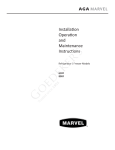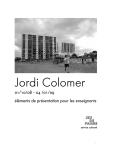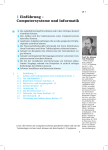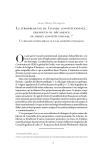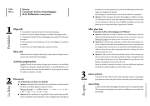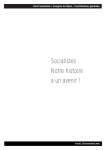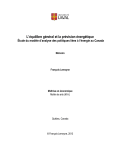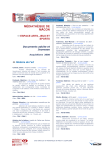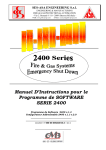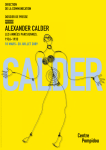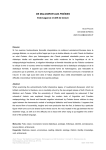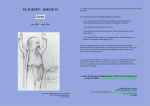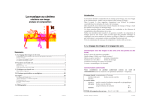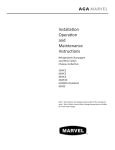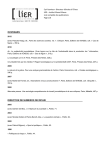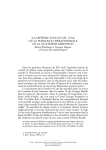Download `la valeur d`usage
Transcript
BIBLIOGRAPHY A. WORKS BY GEORGES BATAILLE 1. BOOKS Histoire de l’oeil. Publié sous le pseudonyme de Lord Auch. Accompagné de huit lithographies d’André Masson. Paris: René Bonnel, 1928. Nouvelle version. Accompagné de six gravures à l’eau-forte et au burin de Hans Bellmer. Paris: K. Editeur, 1944. L’Anus solaire. Illustré de pointes sèches d’André Masson. Paris: Éditions de la Galérie Simon, 1931. Sacrifices. Accompagnant cinq eaux-fortes d’André Masson. Paris: Éditions G.L.M., 1936. Madame Edwarda. Publié sous le pseudonyme de Pierre Angélique. Paris. Éditions du Solitaire, 1941. Réédité, augmenté d’une préface de Georges Bataille. Paris, JeanJacques Pauvert, 1956. L’Expérience intérieure. Paris: Éditions Gallimard, 1943. Réédité, suivie de Méthode de meditation et de Post-scriptum, comme premier tome de La Somme athéologique. Paris: Éditions Gallimard, 1954. Le Petit. Publié sous le pseudonyme de Louis Trente. Paris: Robert Chatté, 1943. Le Coupable. Paris: Éditions Gallimard, 1944. Réédité, augmenté d’une introduction, et suivie de L’Alléluiah, catéchisme de Dianus, comme second tome de La Somme athéologique. Paris: Éditions Gallimard, 1961. L’Archangélique. Paris: Messages, 1944. Sur Nietzsche: Volonté de chance. Paris: Éditions Gallimard, 1945. L’Orestie. Paris: Éditions de Quatre-Vents, 1945. Dirty. Paris: Éditions Fontaine, 1945. L’Alléluiah, catéchisme de Dianus. Accompagné de lithographies de Jean Fautrier. Paris: August Blaizot, 1947. Méthode de méditation. Paris: Éditions Fontaine, 1947. La Haine de la poésie. Paris: Éditions de Minuit, 1947. Réédité comme L’Impossible. Paris: Éditions de Minuit, 1962. La Part maudite: Essai d’économie générale. Tome I. La consumation. Collection L’Usage des richesses. Paris: Éditions de Minuit, 1949. 434 L’Abbé C. Paris: Éditions de Minuit, 1950. Lascaux ou la naissance de l’art. Les grands siècles de la peinture. La peinture préhistorique. Genève: Albert Skira, 1955. Manet. Genève: Albert Skira, 1955. Le Bleu du ciel. Paris: Jean-Jacques Pauvert, 1957. La Littérature et le mal. Paris: Éditions Gallimard, 1957. L’Érotisme. Paris: Éditions de Minuit, 1957. Le Procès de Gilles de Rais. Collection Essais. Paris: Club français du Livre, 1959. Les Larmes d’Eros. Bibliothèque internationale d’érotologie. Édition de J.-M. Lo Duca. Paris: Jean-Jacques Pauvert, 1961. Ma Mère. Paris: Jean-Jacques Pauvert, 1966. Le Mort. Paris: Jean-Jacques Pauvert, 1967. Théorie de la religion. Collection Tel. Paris: Éditions Gallimard, 1973. 2. SELECTED ARTICLES ‘L’amerique disparu’, in L’Art précolumbien: L’Amerique avant Christophe Colomb. Cahiers de la république des lettres des sciences et des arts. Vol. XI. Edited by Pierre d’Espezel. Paris: Les Beaux-Arts, 1928. ‘Le langage des fleurs’, Documents, no. 3 (June 1929). ‘Figure humaine’, Documents, no. 4 (September 1929). ‘Le gros orteil’, Documents, no. 6 (November 1929) ‘Abattoir’, Documents, no. 6 (November 1929). ‘Le “Jeu lugubre”’, Documents, no. 7 (December 1929). ‘Informe’, Documents, no. 7 (December 1929). ‘Le bas matérialisme et la gnose’, Documents, no. 1 (1930). ‘Les écarts de la nature’, Documents, no. 2 (1930). ‘Soleil pourri’, Documents, no. 3, ‘Hommage à Picasso’, numéro special (1930). ‘Bouche’, Documents, no. 5 (1930). ‘L’art primitif’, Documents, no. 7 (1930). ‘La mutilation sacrificielle et l’oreille coupée de Van Gogh’, Documents, no. 8 (1930). ‘L’esprit moderne et le jeu des transpositions’, Documents, no. 8 (1930). ‘La critique des fondements de la dialectique hégélienne’, La Critique sociale, no. 5 (March 1932). ‘La notion de dépense’, La Critique sociale, no. 7 (January 1933). ‘La structure psychologique du fascisme’, La Critique sociale, no. 10 (November 1933). ‘Contre-Attaque. Union de lutte des intellectuels révolutionnaires’ (October 1935). ‘Contre-Attaque: Appel à l’action’ (February 1936). ‘Front populaire dans la rue’, Cahiers de Contre-Attaque, no. 1 (May 1936). 435 ‘Le labyrinthe’, Recherches philosophiques, vol. 5 (1935-36). ‘La conjuration sacrée’, Acéphale, no. 1, ‘La conjuration sacrée’ (June 1936). ‘Montserrat’, Minotaure, no. 8 (June 1936). ‘Propositions’, Acéphale, no. 2, ‘Réparation à Nietzsche’, numéro double (January 1937). ‘L’obélisque’, Mesures, 4e année, no. 2 (April 1938). ‘Corps célestes’, Verve, vol. 1, no. 2 (Spring 1938). ‘L’apprenti sorcier’, in ‘Pour une collège de sociologie’, Nouvelle Revue française, no. 298 (July 1938). ‘Déclaration du collège de sociologie sur la crise internationale’, Nouvelle revue française, no. 302 (November 1938); Esprit, no. 74 (November 1938); and Volontés, no. 11 (November 1938). ‘La folie de Nietzsche’, Acéphale, no. 5 (June 1939). ‘La pratique de la joie devant la mort’, Acéphale, no. 5 (June 1939). ‘Le sacré’, Cahiers d’art, 14e année, no. 1-4 (1939). ‘L’amitié’, Mesures, 6e année, no. 2 (April 1940). ‘Le rire de Nietzsche’, Exercice du silence. Bruxelles, 1942. ‘Discussion sur le péché’, Dieu vivant, no. 4 (1945). ‘À propos d’assoupissements’, Troisième convoi, no. 2 (January 1946). ‘André Masson’, Labyrinthe, no. 19, Genève (May 1946). ‘Le sens moral de la sociologie’, Critique, no. 1 (June 1946). ‘Le surréalisme et sa différence avec l’existentialisme’, Critique, no. 2 (July 1946). ‘Réflexions sur le bourreau et la victime’, Critique, no. 17 (October 1947). ‘De l’existentialisme au primat de l’économie’, Critique, no. 19 (December 1947) and no. 21 (February 1948). ‘L’art, exercice de la cruauté’, Médecine de France, no. 4 (June 1949). ‘L’inceste et le passage de l’animal à l’homme’, Critique, no. 44 (January 1951). ‘La guerre et la philosophie du sacré’, Critique, no. 45 (February 1951). ‘Sommes-nous là pour jouer ou pour être sérieux?, Critique, no. 49 (June 1951) and no. 5152 (August-September 1951). ‘Le temps de la révolte’, Critique, no. 55 (December 1951). ‘La relation de l’expérience mystique a la sensualité’, Critique, no. 60 (May 1952) and no. 63-64 (August-September 1952). ‘Jean-Paul Sartre et l’impossible révolte de Jean Genet’, Critique, no. 65 (October 1952) and no. 66 (November 1952). ‘L’affaire de L’Homme révolté’, Critique, no. 67 (December 1952). ‘Le passage de l’animal à l’homme et la naissance de l’art’, Critique, no. 71 (April 1953). ‘Au rendez-vous de Lascaux, l’homme civilisé se retrouve homme de désir’, Arts, no. 423 (7-13 August 1953). ‘Le non-savoir’, Botteghe oscure, no. 11 (1953). 436 ‘Hegel, la mort et le sacrifice’, Deucalion, no. 5, ‘Études hégéliennes’, no. 40, Être de penser, Cahiers de philosophie, Neuchatel (October 1955). ‘Hegel, l’homme et l’histoire’, Monde nouveau-Paru, no. 96 (January 1956). ‘L’érotisme ou la mise en question de l’être’, Les Lettres nouvelles, no. 36 (March 1956), and no. 37 (April 1956). ‘Qu’est-ce que l’histoire universelle?’, Critique, no. 111-112 (August-September 1956). ‘La religion préhistorique’, Critique, no. 147-148 (August-September 1959). ‘L’enseignement de la mort’ (8-9 May 1952), Tel Quel, no. 10 (Summer 1962). ‘Non-savoir, rire et larmes (9 February 1953)’, Tel Quel, no. 10 (Summer 1962). ‘L’oeil pinéal’, L’Éphémère, no. 3 (September 1967). ‘La valeur d’usage de D.A.F. de Sade’, in ‘Georges Bataille’, L’Arc, no. 32 (1967). ‘La “vieille taupe” et le préfixe sur dans les mots surhomme et surréaliste’, Tel Quel, no. 34 (Summer 1968). ‘Le berceau de l’humanité: La vallée de la Vézère’. Tel Quel, no. 40 (Winter 1970). 3. OEUVRES COMPLÈTES Tome I. Premiers écrits, 1922-1940. Histoire de l’œil – L’Anus solaire – Sacrifices – Articles. Édition de Denis Hollier. Présentation de Michel Foucault. Paris: Éditions Gallimard, 1970. Tome II. Écrits posthumes, 1922-1940. Édition de Denis Hollier. Paris: Éditions Gallimard, 1970. Tome III. Oeuvres littéraires. Madame Edwarda – Le Petit – L’Archangélique – L’Impossible – La Scissiparité – L’Abbé C. – L’Être indifférencié n’est rien – Le Bleu du ciel. Édition de Thadée Klossowski. Paris: Éditions Gallimard, 1971. Tome IV. Oeuvres littéraires posthumes. Poèmes – Le Mort – Julie – La Maison brûlée – La Tombe de Louis XXX – Divinus Deus – Ébauches. Édition de Thadée Klossowski. Paris: Éditions Gallimard, 1971. Tome V. La Somme athéologique. Tome I. L’Expérience intérieure – Méthode de meditation – Post-scriptum 1953 – Le Coupable – L’Alleluiah. Édition Paule Leduc. Paris: Éditions Gallimard, 1973. Tome VI. La Somme athéologique. Tome II. Sur Nietzsche – Mémorandum – Annexes. Édition Henri Ronse et Jean-Michel Rey. Paris: Éditions Gallimard, 1973. Tome VII. L’Économie à la mesure de l’univers – La Part maudite – La Limite de l’utile (fragments) – Théorie de la religion – Conférences 1947-1948 – Annexes. Édition de Thadée Klossowski. Paris: Éditions Gallimard, 1976. Tome VIII. L’Histoire de l’érotisme – Le Surréalisme au jour de jour – Conférences 19511953 – La Souveraineté – Annexes. Édition de Thadée Klossowski. Paris: Éditions Gallimard, 1976. Tome IX. Lascaux ou la naissance de l’art – Manet – La Littérature et le mal – Annexes. Édition de Denis Hollier, avec la collaboration de Dominique Lemann. Paris: Éditions Gallimard, 1979. 437 Tome X. L’Érotisme – Le Procès de Gilles de Rais – Les Larmes d’Éros. Édition de Francis Marmande, avec la collaboration d’Yves Thévenieau. Paris: Éditions Gallimard, 1987. Tome XI. Articles I, 1944-1949. Édition de Francis Marmande, avec la collaboration de Sibylle Monod. Paris: Éditions Gallimard, 1988. Tome XII. Articles II, 1950-1961. Édition de Francis Marmande, avec la collaboration de Sibylle Monod. Paris: Éditions Gallimard, 1988. 4. COLLECTIONS Documents (1929-1930). Réimpression. 2 vols. Préface de Denis Hollier. Paris: Éditions Jean-Michel Place, 1991. L’Apprenti sorcier: Du Cercle Communiste Démocratique à Acéphale. Textes, lettres et documents (1932-1939). Rassemblés, présentés et annotés par Marina Galletti. Préface et notes traduites de l’italien par Natália Vital. Collection Les Éssais. Paris: Édition de la Différence, 1999. Acéphale (1936-1939). Réimpression. Préface de Michel Camus. Paris: Éditions JeanMichel Place, 1995. Le Collège de sociologie, 1937-1939. Présentés par Denis Hollier. Paris: Éditions Gallimard, 1979. Deuxième édition. Collection Folio/Essais. Paris: Éditions Gallimard, 1995. Une liberté souveraine. Textes et entretiens réunis et présentés par Michel Surya. Paris: Farrago, 2000. 5. LETTERS Choix de lettres, 1917-1962. Édition établiée, présentée et annotée par Michel Surya. Paris: Éditions Gallimard, 1997. 6. ENGLISH TRANSLATIONS A Tale of Satisfied Desire. Published under the pseudonym of Pierre Angelique. Translated from the nouvelle version of Histoire de l’œil by Austryn Wainhouse. Paris: Olympia Press, 1953. The Little One. Translated by Paul Buck in Living Hand, no. 1 (Fall 1973), pp. 28-45. Story of the Eye. Translated from the first version of Histoire de l’œil by Joachim Neugroschel. With essays by Susan Sontag and Roland Barthes. London and New York: Marion Boyars, 1977. Blue of Noon. Translated by Harry Mathews. London and New York: Marion Boyars, 1978. Lascaux or the Birth of Art. The Great Centuries of Painting: Prehistoric Painting. Series edited by Albert Skira. Translated by Austryn Wainhouse. London: Macmillan, 1980. L’Abbé C. Translated by Philip A. Facey. London and New York: Marion Boyars, 1983. 438 Manet. Translated by Austryn Wainhouse and James Emmons. With an introduction by Francoise Cachin. London: Macmillan, 1983. Literature and Evil. Translated by Alastair Hamilton. London and New York: Marion Boyars, 1985. Visions of Excess: Selected Writings, 1927-1939. Theory and History of Literature, vol. 14. Series edited by Wlad Godzich and Jochen Schulte-Sasse. Translated by Allan Stoekl, with Carl R. Lovitt and Donald M. Leslie, Jr. Edited, and with an introduction, by Allan Stoekl. Minneapolis, MN: University of Minnesota Press, 1985. Erotism: Death and Sensuality. Translated by Mary Dalwood. San Francisco: City Lights Books, 1986. Writings on Laughter, Sacrifice, Nietzsche, Un-Knowing. Translated by Annette Michelson. With Essays by Rosalind Krauss, Annette Michelson, and Allen S. Weiss. A special issue of October, no. 36 (Spring 1986). The Accursed Share: An Essay on General Economy. Vol. 1. Consumption. Translated by Robert Hurley. New York, NY: Zone Books, 1988. The College of Sociology (1937-39). Edited, and with a foreword, by Denis Hollier. Translated by Betsy Wing. Theory and History of Literature, vol. 41. Series edited by Wlad Godzich and Jochen Schulte-Sasse. Minneapolis: University of Minnesota Press, 1988. Guilty. Translated by Bruce Boone. With an introduction by Denis Hollier. Venice, CA: Lapis Press, 1988. Inner Experience. Translated, with an introduction, by Leslie Anne Boldt. SUNY series Intersections: Philosophy and Critical Theory. Edited by Rodolphe Gasché and Mark C. Taylor. Albany, NY: State University of New York Press, 1988. My Mother. Madame Edwarda. The Dead Man. Translated by Austryn Wainhouse. With essays by Yukio Mishima and Ken Hollings. London and New York: Marion Boyars, 1989. The Tears of Eros. Translated by Peter Connor. With an introduction by J. M. Lo Duca. San Francisco: City Lights Books, 1989. Theory of Religion. Translated by Robert Hurley. New York: Zone Books, 1989. ‘Hegel Death and Sacrifice’, Translated by Jonathan Strauss in Allan Stoekl, ed. ‘On Bataille’. Yale French Studies, no. 78 (1990), pp. 9-28. ‘Letter to René Char on the Incompatibilities of the Writer’. Translated by Christopher Carsten in Allan Stoekl, ed. ‘On Bataille’. Yale French Studies, no. 78 (1990), pp. 29-43. ‘Reflections on the Executioner and the Victim’. Translated by Elizabeth Rottenberg in Claire Nouvet, ed. ‘Litterature and the Ethical Question’. Yale French Studies, no. 79 (1991), pp. 15-19. The Accursed Share: An Essay on General Economy. Vol. 2. The History of Eroticism. Vol. 3. Sovereignty. Translated by Robert Hurley. New York: Zone Books, 1991. The Impossible. Translated by Robert Hurley. San Francisco: City Lights Books, 1991. The Trial of Gilles de Rais. Documents Presented by Georges Bataille. Translated by 439 Richard Robinson Los Angeles, CA: Amok Books, 1991. ‘A Documents Dossier’. Edited by Denis Hollier. A special issue of October, no. 60 (Spring 1992), pp. 25-57. On Nietzsche. Translated by Bruce Boone. With an introduction by Sylvere Lotringer. European Sources. Series edited by Russell Epprecht and Sylvere Lotringer. New York: Paragon House, 1992. The Absence of Myth: Writings on Surrealism. Edited, translated, and with an introduction, by Michael Richardson. London and New York: Verso, 1994. Encyclopaedia Acephalica (Comprising the Critical Dictionary and Related Texts, and the Encyclopaedia Da Costa). Edited, and with an introduction, by Alastair Brotchie. Biographies by Dominique Lecoq. Translated by Iain White, with additional translations by Dominic Faccini, Annette Michelson, John Harman, Alexis Lykiard, etc. Atlas Arkhive Three: Documents of the Avant-Garde. Series edited by Alastair Brotchie, Malcolm Green, Antony Melville, Terry Hale, and Chris Allen. London: Atlas Press, 1995. Essential Writings. Edited and translated by Michael Richardson. Theory, Culture and Society. Series edited by Mike Featherstone. London: SAGE Publications, 1998. The Unfinished System of Nonknowledge. Edited and with an introduction by Stuart Kendall. Translated by Michelle and Stuart Kendall. Minneapolis and London: University of Minnesota Press, 2001. The Cradle of Humanity: Prehistoric Art and Culture. Edited and with an introduction by Stuart Kendall. Translated by Michelle and Stuart Kendall. New York: Zone Books, 2005. B. SELECTED BIBLIOGRAPHY Abel, Lionel. The Intellectual Follies: A memoir of the literary venture in New York and Paris. New York: W. W. Norton, 1984. Addis, William E. and Thomas Arnold. A Catholic Dictionary. Containing some account of the doctrine, discipline, rites, ceremonies, councils, and religious orders of the Catholic Church. Revised, with additions, by T. B. Scannell. Twelfth edition. London: Virtue & Co., Ltd., 1928. Ades, Dawn. Dada and Surrealism Reviewed. Introduction by David Sylvester. With an essay by Elizabeth Cowling. London: Arts Council of Great Britain, 1978. Adkins, Lesley, and Roy A. Adkins. Dictionary of Roman Religion. Oxford: Oxford University Press, 1996. Agamben, Giorgio. Homo sacer: Il potere sovrano e la nuda vita. Turin: Guilio Einaudi, 1995. Translated by Daniel Heller-Roazen as Homo Sacer: Sovereign Power and Bare Life. Meridian: Crossing Aesthetics. Series edited by Werner Hamacher and David E. Wellbery. Stanford, CA: Stanford University Press, 1998. ________. ‘La vie nu’, Revue de littérature générale, no. 1 (1995), p. 410-411. ________. Quel che resta di Auschwitz: L’archivio e il testimone. Turin: Bollati Boringhieri, 1999. Translated by Daniel Heller-Roazen as Remnants of Auschwitz: The Witness and the Archive. New York: Zone Books, 2002. 440 Alféri, Pierre, and Olivier Cadiot. ‘Bataille en relief’, Revue de littérature générale, no. 1 (1995), p. 408. Alley, Ronald. Picasso: The Three Dancers. Tate Modern Masterpieces. Series edited by Richard Calvocoressi. London: The Tate Gallery, 1986. Althusser, Louis. ‘L’Homme, cette nuit’, in Cahiers du Sud, no. 286 (1947). Translated by G. M. Goshgarian as ‘Man, That Night’, in The Spectre of Hegel: Early Writings. Edited, with an introduction, by François Matheron. London and New York: Verso, 1997, pp. 170-172. ________. ‘Marxisme et humanisme’, in Cahiers de l’I.S.E.A. (June 1964). Collected in Pour Marx. Paris: François Maspero, 1965. Translated by Ben Brewster as ‘Marxism and Humanism’, in For Marx. Verso Modern Classics. London: Verso, 1990, pp. 219-241. Améry, Jean. Jenseits von Schuld und Sühne (1966). Translated by Sidney Rosenfeld and Stella P. Rosenfeld as At the Mind’s Limits: Contemplations by a Survivor on Auschwitz and its Realities. London: Granta Books, 1980. Angela of Foligno. Complete Works. The Classics of Western Spirituality. Series edited by Bernard McGinn. Translated, with an introduction, by Paul Lachance, and a preface by Romana Guarnieri. New York: Paulist Press, 1993. Aragon, Louis. Le Paysan de Paris. Paris: Éditions Gallimard, 1926. Translated, with and introduction, by Simon Watson Taylor as Paris Peasant. London: Picador, 1971. ________. Traité du style. Paris: Éditions Gallimard, 1928. Translated, with an introduction, by Alyson Waters as Treatise on Style. Lincoln and London: University of Nebraska Press, 1991. Aragon, Louis, and André Breton. ‘Le Cinquantenaire de l’hysterie (1878-1928)’, La Revolution surréaliste, no. 11, (15 March, 1928), pp. 20-22. Translated by Samuel Beckett as ‘The Fiftieth Anniversary of Hysteria’, in André Breton. What is Surrealism? Selected Writings. Edited and introduced by Franklin Rosemont. London: Pluto Press, 1978, pp. 320-321. Aristotle. Selections. Translated, with an introduction, notes and glossary, by Terence Irwin and Gail Fine. Indianapolis, IN: Hackett Publishing Company, 1995. Aron, Raymond. Memoires: 50 ans de réflexion politique. Paris, 1983. Auffret, Dominique. Alexandre Kojève: la philosophie, l’état, la fin de l’histoire. Paris: Éditions Grasset, 1990. Baratay, Éric, and Élisabeth Hardouin-Fugier. La Corrida. ‘Que sais-je?’, vol. 568. Collection fondée par Paul Angoulvent. Paris: Presses Universitaires de France, 1995. Barthes, Roland. ‘La métaphore de l’oeil’, in ‘Hommage à Georges Bataille’, Critique, no. 195-196 (August-September 1963). Collected in Essais critiques. Paris: Éditions du Seuil, 1964. Translated by Richard Howard as ‘The Metaphor of the Eye’, in Critical Essays. Evanston, IL: Northwestern University Press, 1972. ________. ‘Les sorties du texte’, in Philippe Sollers, ed. Bataille. Actes du colloque du Centre Culturel International de Cerisy-la-Salle, July 1972. Paris: 10/18, 1973. Collected in Le bruissement de la langue. Paris: Éditions du Seuil, 1984. Translated 441 by Richard Howard as ‘Outcomes of the Text’ in The Rustle of Language. Berkeley and Los Angeles: University of California Press, 1986, pp. 238-249. ________. La Chambre claire. Paris: Éditions du Seuil, 1980. Translated by Richard Howard as Camera Lucida. London: Flamingo, 1984. Baudelaire, Charles. Écrits intimes. Collection Incidences. Texte établi par Jacques Crépet. Introduction par Jean-Paul Sartre. Paris: Éditions Point du Jour, 1946. Baudrillard, Jean. L’Echange symbolique et la mort. Paris: Éditions Gallimard, 1976. Translated by Iain Hamilton Grant as Symbolic Exchange and Death. Theory, Culture and Society. Series edited by Mike Featherstone. With an introduction by Mike Gane. London: Sage Publications Ltd, 1993. Baugh, Bruce. French Hegel: From Surrealism to Postmodernism. New York and London: Routledge, 2003. Beauvoir, Simone de. La Force de l’âge. Paris: Éditions Gallimard, 1960. Translated by Peter Green as The Prime of Life. Harmondsworth: Penguin Books, 1965. ________. La Force des choses. Paris: Éditions Gallimard, 1963. Translated by Richard Howard as Force of Circumstance. Harmondsworth: Penguin Books, 1968. Beers, William. Women and Sacrifice: Male Narcissism and the Psychology of Religion. Detroit: Wayne State University Press, 1992. Beizer, Janet. Ventriloquized Bodies: Narratives of Hysteria in Nineteenth-Century France. Ithaca: Cornell University Press, 1994. Beidelman, T. O. W. Robertson Smith and the Sociological Study of Religion. With a foreword by E. E. Evans-Pritchard. London and Chicago: The University of Chicago Press, 1974. Belay, Boris. ‘That Obscure Parallel to the Dialectic: Tangled Lines Between Bataille and Kojève’, in ‘Kojève’s Paris. Now Bataille’, a special issue of Parallax, no. 4 (February 1997), pp. 55-69. Bellmer, Hans. Les Jeux de la poupée. Illustrés de textes par Paul Éluard. Paris: Éditions Premières, 1949. ________. ‘Mode d’emploi’, in Hans Bellmer, a special issue of Obliques (Paris: Éditions Borderie, 1975). Benjamin, Walter. ‘Das Kunstwerk im Zeitalter seiner technischen Reproduzierbarkeit’, Zeitschrift für Sozialforschung, V, no. 1 (1936). Translated by Harry Zohn as ‘The Work of Art in the Age of Mechanical Reproduction’ in Illuminations. Edited, and with an introduction, by Hannah Arendt. London: Fontana Press, 1973, pp. 211244. Bernheimer, Charles. ‘Huysmans: Syphilis, Hysteria, and Sublimation’, in Figures of Ill Repute: Representing Prostitution in Nineteenth-Century France. Durham and London: Duke University Press, 1997, pp. 234-265. Bernier, Jean, L’Amour de Laure. Paris: Flammarion, 1978. Blake, William. Blake’s Poetry and Designs. A Norton Critical Edition. Edited by Mary Lynn Johnson and John E. Grant. New York and London: W. W. Norton & Company, 1979. 442 Blanchot, Maurice. Thomas l’obscur. Paris: Éditions Gallimard, 1941. Nouvelle version. Paris: Éditions Gallimard, 1950. Translated from the ‘nouvelle version’ by Robert Lamberton as Thomas the Obscure. New York: Station Hill, 1973. ________. ‘L’Expérience intérieure’, Journal des débats, no. 3 (May 1943). Collected in Faux-pas. Paris: Éditions Gallimard, 1943. Translated by Charlotte Mandell as ‘Inner Experience’, in Faux Pas. Crossing Aesthetics. Series edited by Werner Hamacher and David E. Wellbery. Stanford, CA: Stanford University Press, 2001, pp. 37-41. ________. ‘Quelques réflexions sur le surréalisme’, L’Arche, no. 8 (August 1945). Collected in La Part du feu. Paris: Éditions Gallimard, 1949. Translated by Charlotte Mandell as ‘Reflections on Surrealism’, in The Work of Fire. Crossing Aesthetics. Series edited by Werner Hamacher and David E. Wellbery. Stanford, CA: Stanford University Press, 1995, pp. 85-97. ________. ‘Du côté de Nietzsche’, L’Arche, no. 12 (December 1945-January 1946). Collected in La Part du feu. Paris: Éditions Gallimard, 1949. Translated by Charlotte Mandell as ‘On Nietzsche’s Side’, in The Work of Fire. Crossing Aesthetics. Series edited by Werner Hamacher and David E. Wellbery. Stanford, CA: Stanford University Press, 1995, pp. 287-299. ________. ‘Le Règne animal de l’esprit’, Critique, no. 18 (November 1947). Reprinted as part one of ‘La littérature et le droit à la mort’, in La Part du feu. Paris: Éditions Gallimard, 1949. Translated by Charlotte Mandell as part one of ‘Literature and the Right to Death’, in The Work of Fire. Crossing Aesthetics. Series edited by Werner Hamacher and David E. Wellbery. Stanford, CA: Stanford University Press, 1995, pp. 300-322. ________. ‘La littérature et le droit à la mort’, Critique, no. 20 (January 1948). Reprinted as part two of ‘La littérature et le droit à la mort’, in La Part du feu. Paris: Éditions Gallimard, 1949. Translated by Charlotte Mandell as part two of ‘Literature and the Right to Death’, in The Work of Fire. Crossing Aesthetics. Series edited by Werner Hamacher and David E. Wellbery. Stanford, CA: Stanford University Press, 1995, pp. 322-344. ________. Lautréamont et Sade. Paris: Éditions de Minuit, 1949. Translated by Stuart and Michelle Kendall as Lautréamont and Sade. Crossing Aesthetics. Series edited by Werner Hamacher and David E. Wellbery. Stanford, CA: Stanford University Press, 2004. ________. ‘Naissance de l’art’, La Nouvelle revue française, no. 35 (November 1955). Collected in L’Amitié. Paris: Éditions Gallimard, 1971. Translated by Elizabeth Rottenberg as ‘The Birth of Art’, in Friendship. Series edited by Werner Hamacher and David E. Wellbery. Stanford, CA: Stanford University Press, 1997, pp. 1-11 ________. ‘Pierre Angélique: Madame Edwarda’, Nouvelle revue française, no. 43 (July 1956), pp. 148-150. Reprinted as ‘Le récit et le scandale’, in Le Livre à venir. Paris: Éditions Gallimard, 1959. ________. ‘Passage de la ligne’, Nouvelle revue française, no. 69 (September 1958). Collected in L’Entretien infini. Paris: Éditions Gallimard, 1969. Translated by Susan Hanson as ‘Crossing the Line’, in The Infinite Conversation. Theory and History of Literature, vol. 82. Series edited by Wlad Godzich and Jochen Schulte-Sasse. 443 Minneapolis: University of Minnesota Press, 1993, pp. 143-151. ________. ‘L’Amitié’, Les Lettres nouvelles, no. 29 (October 1962). Collected in L’Amitié. Paris: Éditions Gallimard, 1971. Translated by Elizabeth Rottenberg as ‘Friendship’, in Friendship. Crossing Aesthetics. Series edited by Werner Hamacher and David E. Wellbery. Stanford, CA: Stanford University Press, 1997, pp. 289-292. ________. ‘L’Expérience-limite’, Nouvelle revue française, no. 118 (October 1962). Reprinted as ‘L’affirmation et la passion de la pensée négative’, in L’Entretien infini. Paris: Éditions Gallimard, 1969. Translated by Susan Hanson as ‘Affirmation and the Passion of Negative Thought’, in The Infinite Conversation. Theory and History of Literature, vol. 82. Series edited by Wlad Godzich and Jochen Schulte-Sasse. Minneapolis: University of Minnesota Press, 1993, pp. 202-211. ________. ‘Le jeu de la pensée’, in ‘Hommage à Georges Bataille’, Critique, no. 195-196 (August-September 1963). Collected in L’Entretien infini. Paris: Éditions Gallimard, 1969. Translated by Susan Hanson as ‘The Play of Thought’, in The Infinite Conversation. Theory and History of Literature, vol. 82. Series edited by Wlad Godzich and Jochen Schulte-Sasse. Minneapolis: University of Minnesota Press, 1993, pp. 211-217. ________. ‘Sur un changement d’époque: L’exigence du retour’, in L’Entretien infini. Paris: Éditions Gallimard, 1969. Translated by Susan Hanson as ‘On a Change of Epoch: The Exigency of Return’, in The Infinite Conversation. Theory and History of Literature, vol. 82. Series edited by Wlad Godzich and Jochen Schulte-Sasse. Minneapolis: University of Minnesota Press, 1993, pp. 264-281. ________. La Communauté inavouable. Paris: Éditions de Minuit, 1983. Translated by Pierre Joris as The Unavowable Community. Barrytown, NY: Station Hill Press, 1988. Blossfeldt, Karl. Urformen der Kunst: Photographische Pflanzenbilder von Professor Karl Blossfeldt. Edited, and with an introduction, by Karl Nierendorf. Berlin: Wasmuth Verlag, 1928. Bois, Yve-Alain, Benjamin Buchloh, Hal Foster, Denis Hollier, Rosalind Krauss, and Helen Molesworth. ‘The Politics of the Signifier II: A Conversation on the Informe and the Abject’, October, no. 67 (Winter 1994), pp. 3-21. Bois, Yve-Alain, and Rosalind Krauss. L’Informe: mode d’emploi. Paris: Éditions du Centre Georges Pompidou, 1996. Translated as Formless: A User’s Guide. New York: Zone Books, 1997. Boldt-Irons, Leslie Anne, ed. On Bataille: Critical Essays. Translated, and with an introduction, by Leslie Anne Boldt-Irons. Intersections: Philosophy and Critical Theory. SUNY series edited by Rodolphe Gasché. Albany, NY: State University of New York Press, 1995. Bonaparte, Marie. ‘De l’essentielle ambivalence d’Eros’, Revue française de psychanalyse, no. 2 (1948). Borch-Jacobsen, Mikkel. Lacan: The Absolute Master. Translated by Douglas Brick. Stanford, CA: Stanford University Press, 1991. Bourneville, Désiré-Magloire, and Paul Régnard, Iconographie photographique de la Salpêtrière. Vol. 2. Paris: Progrès Médical, 1878. 444 Breton, André. Manifeste du surréalisme. Paris: Éditions du Sagittaire, 1924. Translated by Richard Seaver and Helen R. Lane as Manifesto of Surrealism, in Manifestoes of Surrealism. Ann Arbor: The University of Michigan Press, 1969, pp. 1-47. ________. ‘Léon Trotsky: Lénine’, La Révolution surréaliste, no. 5 (October 1925). ________. ‘Légitime défense’, La Révolution surréaliste, no. 8 (December 1926). Translated by Richard Howard as ‘Legitimate Defence’ in What is Surrealism? Selected Writings. Edited and introduced by Franklin Rosemont. London: Pluto Press, 1978, pp. 31-42. ________. Le Surréalisme et la peinture. Paris: Éditions Gallimard, 1928. Translated by Simon Watson Taylor in Surrealism and Painting. New York: Harper and Row, 1972, pp. 1-48. ________. Nadja. Paris: Éditions Gallimard, 1928. Translated by Richard Howard as Nadja. New York: Grove Press, 1960. ________. ‘Second manifeste du surréalisme’, La Revolution surréaliste, no. 12 (December 1929). Reprinted as Second manifeste du surréalisme. Paris: Simon Kra, 1930. Translated by Richard Seaver and Helen R. Lane as Second Manifesto of Surrealism, in Manifestoes of Surrealism. Ann Arbor: The University of Michigan Press, 1969, pp. 117-194. ________. Les Vases communicants. Paris: Éditions des Cahiers Libres, 1932. Translated by Mary Ann Caws and Geoffrey T. Harris as Communicating Vessels. With notes and an introduction by Mary Ann Caws. French Modernist Library. Series edited by Mary Ann Caws, Richard Howard and Patricia Terry. Lincoln, NE, and London: University of Nebraska Press, 1990. ________. Point du jour. Paris: Éditions Nouvelle Revue française, 1934. Translated, with a foreword and preface, by Mark Polizzotti and Mary Ann Caws as Break of Day. French Modernist Library. Series edited by Mary Ann Caws, Richard Howard and Patricia Terry. Lincoln, NE, and London: University of Nebraska Press, 1999. ________. ‘Discours au congrès des écrivains’. Collected in Position politique du surréalisme. Paris: Éditions du Sagittaire, 1935. Translated by Richard Seaver and Helen R. Lane as ‘Speech to the Congress of Writers’, in Manifestoes of Surrealism. Ann Arbor: The University of Michigan Press, 1969, pp. 234-241. ________. L’Amour fou. Paris: Éditions Gallimard, 1937. Translated by Mary Ann Caws as Mad Love. French Modernist Library. Series edited by Mary Ann Caws, Richard Howard and Patricia Terry. Lincoln and London: University of Nebraska Press, 1987. ________. ‘Dialogue entre André Breton et Aimé Patri à propos de L’Homme révolté d’Albert Camus’, Arts (16 November, 1951). ________. Entretiens. Avec André Parinaud. Paris: Éditions Gallimard, 1952. Translated, and with an introduction, by Mark Polizzotti as Conversations: The Autobiography of Surrealism. European Sources. Series edited by Russell Epprecht and Sylvère Lotringer. New York: Marlowe and Company, 1993. ________. La Clé des champs. Paris: Éditions du Sagittaire, 1953. Translated by Michel Parmentier and Jacqueline d’Amboise as Free Rein. French Modernist Library. Series edited by Mary Ann Caws, Richard Howard and Patricia Terry. Lincoln and 445 London: University of Nebraska Press, 1995. ________. Oeuvres complètes. 3 vols. Édition établie par Marguerite Bonnet, avec la collaboration de Philippe Bernier, Étienne-Alain Hubert et José Pierre. Paris: Éditions Gallimard, 1988-1999. Breton, André, ed. La Révolution surréaliste (1924-1929). Reprint. With an introduction by Georges Sebbag. Paris: Éditions Jean-Michel Place, 1975. Breuer, Josef, and Sigmund Freud. Studien über Hysterie. Leipzig and Vienna, 1895. Translated by James and Alix Strachey as Studies on Hysteria. Penguin Freud Library. Vol 3. Edited by Angela Richards. Harmondsworth: Penguin Books, 1974. Breuil, Henri. Quatre cents siècles d’art pariétal. Les Cavernes ornées de l’age du renne. Montignac: Centre d’Études et de Documentation Préhistoriques, 1952. Brontë, Emily. The Complete Poems. Edited, with an introduction, by Janet Gezari. Harmondsworth: Penguin Books, 1992. Bruno, Jean. ‘Les Techniques d’illumination chez Georges Bataille’, in ‘Hommage à Georges Bataille’, Critique, no. 195-196 (August-September 1963), pp. 706-720. Bruno de Jésus-Marie, Father, ‘A propos de la Madeleine de Pierre Janet’, Études Carmélitaines, vol. XVI, no. 1 (1931), pp. 20-61. Bruno de Jésus-Marie, Father, ed. Mystique et Continence: Travaux du VIIe Congrés international d’Avon. 31e année de la Revue Carmélitaine. Desclée de Brouwer, 1952. Bürger, Peter. Theorie der Avantgarde. Frankfurt: Suhrkamp Verlag, 1974. Translated by Michael Shaw from the second edition as Theory of the Avant-Garde. With a foreword by Jochen Schulte-Sasse. Theory and History of Literature, vol. 4; series edited by Wlad Godzich and Jochen Schulte-Sasse. Minneapolis: University of Minnesota Press, 1984. Butler, Judith P. Subjects of Desire: Hegelian Reflections in Twentieth-Century France. New York: Columbia University Press, 1987. Caillé, Alain. ‘Sacrifice, don et utilitarisme; notes sur la théorie du sacrifice’, in ‘A quoi bon (se) sacrifier? Sacrifice, don et intérêt’, Revue du MAUSS semestrielle, no. 5, premièr semestre. Paris: Éditions La Découverte, 1995, pp. 248-292. Caillois, Roger. ‘Le vent d’hiver’, in ‘Pour un Collège de sociologie’, Nouvelle revue française, no. 298 (July 1938), pp. 26-38. Collected in Denis Hollier, ed. Le Collège de Sociologie, 1937-1938. Deuxième édition. Collection Folio/Essais. Paris: Éditions Gallimard, 1995. Translated by Betsy Wing as ‘The Winter Wind’, in The College of Sociology (1937-38). Theory and History of Literature, vol. 41. Series edited by Wlad Godzich and Jochen Schulte-Sasse. Minneapolis: University of Minnesota Press, 1988, pp. 32-42. ________. ‘Ambiguïté du sacré’, Mesures, 5e année, no. 2 (April 1939), pp. 35-64. ________. ‘Théorie de la fête’, Nouvelle revue française, no. 315 (December 1939), pp. 863-882, and no. 316 (January 1940), pp. 49-59. ________. L’Homme et le sacré. Paris: Presses Universitaires de France, 1939. Édition augmentée de trois appendices sur le sexe, le jeu, la guerre dans leurs rapports avec le sacré. Collection Folio/Essais. Paris: Éditions Gallimard, 1950. Translated by 446 Meyer Barash as Man and the Sacred. Illinois: The Free Press of Glencoe, 1959. ________. ‘Divergencies et complicités’, in ‘Hommage à André Breton’, Nouvelle revue française, no. 172 (April 1967), pp. 686-698. ________. ‘Entretién avec Gilles Lapouge’, La Quinzaine littéraire, no. 70 (16-30 June, 1970). ________. ‘The Collège de sociologie: Paradox of an Active Sociologie’. Translated by Susan Lanser. Sub-Stance, no. 11-12 (1975), pp. 61-64. Camus, Albert. L’Homme révolté. Collection Folio/Essais. Paris: Éditions Gallimard, 1951. Partially translated by Anthony Bower as The Rebel. With a foreword by Herbert read. Harmondsworth: Penguin Books, 1971. ________. ‘Une lettre d’Albert Camus en reponse à André Breton’, Arts (October 19, 1951). ________. ‘Lettre au directeur des Temps modernes’, Les Temps modernes, no. 82 (August 1952), pp. 317-333. Carpeaux, Louis. Pékin qui s’en va. Edited by A. Maloine. Paris, 1913. Carrasco, Davíd. City of Sacrifice: The Aztec Empire and the Role of Violence in Civilisation. Boston: Beacon Press, 1999. Caws, Mary Ann. ‘Ladies Shot and Painted: Female Embodiment in Surrealist Art’, in The Art of Interference: Stressed Readings in Verbal and Visual Texts. Cambridge: Polity Press, 1989, pp. 111-134. Chadwick, Whitney, ed. Mirror Images: Women, Surrealism and Self-Representation. Cambridge, MA, and London: The MIT Press, 1998. Chapsal, Madeleine. ‘Georges Bataille’, in Quinze écrivains. Paris: Éditions Juillard, 1963, pp. 9-22. Translated by Michael Richardson in Georges Bataille. Essential Writings. Edited by Michael Richardson. Theory, Culture and Society; series edited by Mike Featherstone. London: SAGE Publications, 1998, pp. 220-224. Charcot, Jean-Martin, and Paul Richer. Les Démoniaques dans l’art. Paris: Adrien Delahaye et Émile Lecrosnier, 1887. Clendinnen, Inga. Aztecs: An Interpretation. Cambridge: Cambridge University Press, 1991. Clifford, James. The Predicament of Culture: Twentieth-Century Ethnography, Literature, and Art. Cambridge, MA, and London: Harvard University Press, 1988. Codex Magliabechiano (mid-sixteenth century). Biblioteca Nazionale Centrale, Florence. Reproduced in facsimile as The Book of the Life of the Ancient Mexicans, Containing An Account of Their Rites and Superstitions. Translated, with an introduction and commentary, by Zelia Nuttall. Berkeley: University of California Press, 1903. Codex Vaticanus A. 3738 (1566-89). Vatican Library. A facsimile and transcription of which is edited by Franz Ehrle. Il manoscritto messicano Vaticano 3738 detto il Codice Ríos riprodotto in fotocromografia a spese de Sua Eccellenza il Duca di Loubat per cura della Biblioteca Vaticana. Rome: Stabilimento Danesi, 1900. Comay, Rebecca. ‘Gifts without Presents: Economies of “Experience” in Bataille and Heidegger’, in Allan Stoekl, ed. ‘On Bataille’. Yale French Studies, no. 78 (1990), 447 pp. 66-89. Connor, Peter Tracey. Georges Bataille and the Mysticism of Sin. Baltimore and London: The Johns Hopkins University Press, 2000. Cooper, Barry. The End of History: An Essay on modern Hegelianism. Toronto: University of Toronto Press, 1984. Cooper, William Earnshaw. The Blood-Guiltiness of Christendom: Its Results and Penalties. London: The Order of the Golden Age, 1922. Cowling, Elizabeth. ‘“Proudly we Claim Him as One of Us”: Breton, Picasso, and the Surrealist Movement’, Art History, vol. 8, no. 1 (March 1985), pp. 82-104. ________. Picasso: Style and Meaning. London: Phaidon Press, 2002. Cox, Neil. ‘Marat/Sade/Picasso’, in ‘Psychoanalysis in Art History’. A special issue of Art History, vol. 17, no. 3 (September 1994), pp. 383-417. ________. ‘Critique of Pure Desire, or When the Surrealists Were Right’, in Jennifer Mundy, ed., Surrealism: Desire Unbound. London Tate Publishing, 2001, pp. 245273. Croce, Benedetto. Ce qui est vivant et ce qui est mort de la Philosophie de Hegel. Étude suivie d’un essai de bibliographie hégélienne. Traduit de l’italien par Henri Buriot. Paris: V. Giard et E. Brière, 1910. Translated by Douglas Ainslie from the third Italian edition of 1912 as What is Living and what is Dead of the Philosophy of Hegel. London: MacMillan and Co., 1915. Cullen, Deborah, ed. Bataille’s Eye. Santa Monica, CA: The Institute of Cultural Enquiry, 1997. Debord, Guy. La société du spectacle. Paris: Buchet-Chastel, 1967. Translated by Donald Nicholson-Smith as The Society of the Spectacle. New York, NY: Zone Books, 1996. Deleuze, Gilles. Nietzsche et la philosophie. Paris: Presses Universitaires de France, 1962. Translated by Hugh Tomlinson as Nietzsche and Philosophy. London: Athlone Press, 1983. ________. Presentation de Sacher-Masoch. Paris: Éditions de Minuit, 1967. Translated by Jean McNeil as Masochism: An Interpretation of Coldness and Cruelty. Together with the entire text of Venus in Furs, by Leopold von Sacher-Masoch. New York: George Braziller, 1971. Derrida, Jacques. ‘De l’économie restreinte à l’économie générale: Un hegelianisme sans réserve’, L’Arc (May 1967). Collected in L’Écriture et la différence. Paris: Éditions du Seuil, 1967. Translated by Alan Bass as ‘From Restricted to General Economy: A Hegelianism without Reserve’, in Writing and Difference. With an introduction and notes by Alan Bass. London: Routledge, 1978, pp. 251-277. ________. ‘Les fins de l’homme’, in Marges de la philosophie. Paris: Éditions de Minuit, 1972. Translated, with Additional Notes, by Alan Bass as ‘The Ends of Man’, in Margins of Philosophy. Chicago: University of Chicago Press, 1982. ________. ‘Derrida l’insoumis’, Le Nouvel observateur, no. 983 (September 1983). Collected in Points de suspension, Entretiens. Paris: Éditions Galilée, 1992. Translated by Peggy Kamuf as ‘Unsealing (“the old new language”)’, in Points: 448 Interviews, 1974-1994. Edited by Werner Hamacher and David E. Wellberg. Stanford, CA: Stanford University Press, 1995. ________. Donner le temps. 1. La fausse monnaie. Paris: Éditions Galilée, 1991. Translated by Peggy Kamuf as Given Time: 1. Counterfeit Money. Chicago and London: The University of Chicago Press, 1992. Descombes, Vincent. Le même et l’autre: Quarante-cinq ans de philosophie française (1933-1978). Paris: Les Éditions de Minuit, 1979. Translated by L. Scott-Fox and J. M. Harding as Modern French Philosophy. Cambridge: Cambridge University Press, 1980. ________. ‘Le moment français de Nietzsche’, in Luc Ferry and Alain Renaut, eds. Pourquoi nous ne sommes pas nietzschéens. Paris: Éditions Grasset et Fasquelle, 1991. Translated by Robert de Loaiza as ‘Nietzsche’s French Moment’, in Why we are Not Nietzscheans. Chicago and London: The University of Chicago Press, 1997, pp. 70-91. Díaz del Castillo, Bernal. Historia verdadera de la conquista de la Nueva España (c. 1555). 2 vols. Mexico, 1904. Translated, with an introduction, notes and appendices by Denis Jourdanet as Histoire véridique de la conquête de la nouvelle-espagne. 2nd corrected edition. Paris: G. Masson, 1877. Translated, introduced and with notes, by Alfred Percival Maudslay as The True History of the Conquest of New Spain. 5 vols. London: Hakluyt Society, 1908. Didi-Huberman, Georges. Invention de l’hystérie: Charcot et photographique de la Salpêtrière. Paris: Éditions Macula, 1982. l’iconographie ________. La Ressemblance informe, ou le gai savoir visuel selon Georges Bataille. Paris: Éditions Macula, 1995. Dostoyevsky, Fyodor. Notes From Underground (1864). Translated an annotated by Richard Pevear and Larissa Volokhonsky. London: Vintage, 1993. Drinka, George Frederick. The Birth of Neurosis: Myth, Malady, and the Victorians. New York: Simon and Schuster, 1984. Drury, Shadia B. Alexandre Kojève: The Roots of Postmodern Politics. London: The MacMillan Press, 1994. Dumas, Georges. Traité de psychologie. 2 vols. Paris: Félix Alcan, 1923. Dumas, Georges, ed. Nouveau traité de psychologie. Vol 2. Les fondements de la vie mentale. Paris: Félix Alcan, 1932. ________, ed. Nouveau traité de psychologie. Vol. 3. Les associations sensitivo-motrices. Paris: Félix Alcan, 1933. Dumézil, Georges. Ouranos-Varuna: Étude de mythologie comparée indo-européene. Paris: Adrien Maisonneuve, 1934. ________. Mitra-Varuna: Essai sur deux représentations indo-européenes de la souveraineté. Bibliothèque de l’École des Hautes Études. Section des Religieuses, vol. LVI. Paris: Leroux, 1940. Translated by Derek Coltman from the second, revised edition of 1948 as Mitra-Varuna: An Essay on Two Indo-European Representations of Sovereignty. New York: Zone Books, 1988. 449 Durkheim, Émile. Les Règles de la méthode sociologique. Paris: Alcan, 1895. Deuxième édition, revue et augmentée d’une préface nouvelle. Paris: Alcan, 1901. Translated by S. A. Solovay and J. H. Mueller as The Rules of Sociological Method. Edited, with an introduction, by G. E. G. Catlin. Chicago: University of Chicago Press, 1938. Republished by Glencoe, Ill.: Free Press of Glencoe, 1950. ________. Les Formes élémentaires de la vie religieuse: Le système totémique en Australie. Bibliothèque de philosophie contémporaine. Paris: Félix Alcan, 1912. Translated, with an introduction, by Karen E. Fields as The Elementary Forms of Religious Life. New York: The Free Press, 1995. Durkheim, Émile, and Marcel Mauss. ‘De quelques formes primitives de classification: contribution à l’étude des répresentations collectives’, in L’Année sociologique, vol. 6 (1903). Translated, edited, with an introduction, by Rodney Needham as Primitive Classification. London: Cohen and West; and Chicago: University of Chicago Press, 1963. Duthuit, Georges. ‘Représentations de la mort’, Cahiers d’art, 14e année, no. 1-4 (1939), pp. 25-39. Einstein, Carl. ‘Picasso’, in ‘Hommage à Picasso’, Documents, no. 3 (1930), pp. 155-157. Eliade, Mircea. The Sacred and the Profane: The Nature of Religion. Translated from the unpublished French by Willard R. Trask. Harper Torchbooks: The Cloister Library. New York and Evanston: Harper & Row, 1961. Ellenberger, Henri F. The Discovery of the Unconscious: The History and Evolution of Dynamic Psychiatry. London: Fontana Press, 1994. Evans, Martha Noel. Fits and Starts: A Genealogy of Hysteria in Modern France. Ithaca: Cornell University Press, 1991. Fer, Briony. ‘Poussière/peinture: Bataille on Painting’, in Carolyn Bailey Gill, ed. Bataille: Writing the Sacred. Warwick Studies in European Philosophy. Series edited by Andrew Benjamin. London and New York, 1995, pp. 154-171. Feuerbach, Ludwig. Das Wesen der Christentums (1841); translated by George Eliot as The Essence of Christianity (1853). New York: Prometheus Books, 1989. Florman, Lisa. Myth and Metamorphosis: Picasso’s Classical Prints of the 1930s. Cambridge, MA, and London: The MIT Press, 2000. Foster, Hal. Compulsive Beauty. October Books. Series edited by Annette Michelson, Rosalind Krauss, Yve-Alain Bois, Benjamin Buchloh, Hal Foster, Denis Hollier, and John Rajchman. Cambridge, MA, and London: The MIT Press, 1993. ________. The Return of the Real: The Avant-Garde at the End of the Century. October Books. Series edited by Annette Michelson, Rosalind Krauss, Yve-Alain Bois, Benjamin Buchloh, Hal Foster, Denis Hollier, and Sylvia Kolbowski. Cambridge, MA, and London: The MIT Press, 1996. ________. Hal Foster. ‘Violation and Veiling in Surrealist Photography: Woman as Fetish, as Shattered Object, as Phallus’, in Jennifer Mundy, ed. Surrealism: Desire Unbound. London: Tate Publishing, 2001, pp. 203-222. Foucault, Michel. ‘Préface à la transgression’, in ‘Hommage à Georges Bataille’, Critique, no. 195-196 (August-September, 1963). Translated by Donald F. Bouchard and 450 Sherry Simon as ‘A Preface to Transgression’, in Language, Counter-Memory, Practice: Selected Essays and Interviews. Edited, with an introduction, by Donald F. Bouchard. Ithaca, NY: Cornell University Press, 1977, pp. 29-52. ________. Les Mots et les choses. Paris: Éditions Gallimard, 1966. Translated by Alan Sheridan as The Order of Things: An Archaeology of the Human Sciences. New York: Random House, 1970. Fraser, Robert. The Making of the Golden Bough: The Origins and Growth of an Argument. London: Macmillan, 1990. Frazer, James. ‘Totemism’. Encyclopaedia Britannica, Ninth edition. Vol. 23. Edinburgh: Adam and Charles Black, 1888. ________. ‘Taboo’. Encyclopaedia Britannica. Ninth edition. Vol. 23. Edinburgh: Adam and Charles Black, 1888. Reprinted in Garnered Sheaves: Essays, Addresses, and Reviews. London: Macmillan & Co., Ltd., 1931, pp. 80-92. ________. Totemism and Exogamy: A Treatise on Certain Early Forms of Superstition and Society. 4 vols. London: Macmillan, 1910. ________. The Dying God. Part III of The Golden Bough: A Study in Magic and Religion. 3rd edition. London: Macmillan and Co., Ltd., 1911. ________. The Scapegoat. Part VI of The Golden Bough: A Study in Magic and Religion. 3rd edition. London: MacMillan and Co., Ltd., 1913. ________. The Golden Bough: A Study in Magic and Religion. Abridged edition (1922). With an introduction by George W. Stocking, Jr. Harmondsworth: Penguin Books, 1998. ffrench, Patrick. ‘The Corpse of Theory: Bataille/Blanchot C Excavation of an Encounter’, in ‘Kojève’s Paris. Now Bataille’, a special issue of Parallax, no. 4 (February 1997), pp. 99-117. ________. The Cut / Reading Bataille’s Histoire de l’oeil. A British Academy Postdoctoral Fellowship Monograph. Oxford: Oxford University Press, 1999. Freud, Sigmund. Die Traumdeutung. Leipzig and Vienna, 1900. Translated from the eighth edition (1930) by James Strachey as The Interpretation of Dreams. Penguin Freud Library. Vol. 4. Edited by Angela Richards. Harmondsworth: Penguin Books, 1976. ________. Drei Abhandlungen zur Sexualtheorie. Leipzig and Vienna: Deuticke, 1905. Translated by James Strachey as Three Essays on the Theory of Sexuality, in On Sexuality. Penguin Freud Library. Vol. 7. Edited by Angela Richards. Harmondsworth: Penguin Books, 1977, pp. 31-169. ________. ‘Die “Kulturelle” Sexualmoral und die Moderne Nervosität’ (1908). Translated by James Strachey as ‘“Civilised” Sexual Morality and Modern Nervous Illness’ in Civilization, Society and Religion. Penguin Freud Library. Vol. 12. Edited by Albert Dickson. Harmondsworth: Penguin Books, 1985, pp. 27-55. ________. ‘Über den Gegensinn der Urworte’ (1910). Translated as ‘The Antithetical Meaning of Primal Words’, in Five Lectures on Psycho-analysis, Leonardo da Vinci, and Other Works. The Standard Edition of the Complete Psychological Works of Sigmund Freud. Vol. 11. Translated from the German under the general editorship of James Strachey, in collaboration with Anna Freud, assisted by Alix Strachey and 451 Alan Tyson. London: The Hogarth Press and the Institute of Psycho-Analysis, 1957, pp. 153-161. ________. ‘Beiträge zur Psychologie des Liebeslebens II: Über die allgemeinste Erniedrigung des Liebeslebens’ (1912). Translated by James Strachey as ‘On the Universal Tendency to Debasement in the Sphere of Love (Contributions to the Psychology of Love II)’, in On Sexuality. Penguin Freud Library. Vol. 7. Edited by Angela Richards. Harmondsworth: Penguin Books, 1977, pp. 243-260. ________. Totem und Tabu. Leipzig and Vienna: Heller, 1913. Translated by James Strachey as Totem and Taboo: Some Points of Agreement between the Mental Lives of Savages and Neurotics, in The Origins of Religion. Penguin Freud Library. Vol. 13. Edited by Albert Dickson. Harmondsworth: Penguin Books, 1985, pp. 43-224. ________. ‘Triebe und Triebschicksale’ (1915). Translated by James Strachey as ‘Instincts and their Vicissitudes’, in On Metapsychology: The Theory of Psychoanalysis. Penguin Freud Library. Vol. 11. Edited by Angela Richards. Harmondsworth: Penguin Books, 1984, pp. 105-138. ________. ‘Die Verdrängung’ (1915). Translated by James Strachey as ‘Repression’, in On Metapsychology: The Theory of Psychoanalysis, Penguin Freud Library, vol. 11, edited by Angela Richards. Harmondsworth: Penguin Books, 1984, pp. 139-158. ________. ‘Das Unheimliche’ (1919). Translated by James Strachey as ‘The “Uncanny”’, in Art and Literature. Penguin Freud Library. Vol. 14. Edited by Albert Dickson. Harmondsworth: Penguin Books, 1985, pp. 335-376. ________. Jenseits des Lustprinzips. Leipzig, Vienna and Zurich: Internationaler Psychoanalytischer Verlag, 1920. Translated by James Strachey as Beyond the Pleasure Principle, in On Metapsychology: The Theory of Psychoanalysis. Penguin Freud Library. Vol. 11. Edited by Angela Richards. Harmondsworth: Penguin Books, 1984, pp. 269-338. ________. Das Ich und das Es. Leipzig, Vienna and Zurich: Internationaler Psychoanalytischer Verlag, 1923. Translated by James Strachey as The Ego and the Id, in On Metapsychology: The Theory of Psychoanalysis. Penguin Freud Library. Vol. 11. Edited by Angela Richards. Harmondsworth: Penguin Books, 1984, pp. 339-407. ________. ‘Das Ökonomische Problem der Masochism’ (1924). Translated by James Strachey as ‘The Economic Problem of Masochism’ in On Metapsychology: The Theory of Psychoanalysis. Penguin Freud Library. Vol. 11. Edited by Angela Richards. Harmondsworth: Penguin Books, 1984, pp. 409-426. Fukuyama, Francis. The End of History and the Last Man. Harmondsworth: Penguin Books, 1992. Gadamer, Hans-Georg. ‘Hegels Dialektik des Selbstbewußtseins’, in Materialien zu Hegels “Phänomenologie des Geistes”. Edited by Hans Friedrich Fulda and Dieter Heurich. Franckfurt: Suhrkamp, 1973. Translated by P. Christopher Smith as ‘Hegel’s Dialectic of Self-Consciousness’, in Hegel’s Dialectic: Five Hermeneutical Studies. With an introduction by P. Christopher Smith. New Haven and London: Yale University Press, 1976, pp. 54-74. Gallop, Jane. Intersections: A Reading of Sade with Bataille, Blanchot, and Klossowski. 452 Lincoln and London: University of Nebraska Press, 1981. Gemerchak, Christopher M. The Sunday of the Negative: Reading Bataille Reading Hegel. SUNY series in Hegelian Studies. Edited by William Desmond. Albany: State University of New York Press, 2003. Gill, Carolyn Bailey, ed. Bataille: Writing the Sacred. Papers presented at the International Conference on Georges Bataille in London, May 13-17, 1991. Warwick Studies in European Philosophy. Series edited by Andrew Benjamin. London and New York: Routledge, 1995. Gilman, Sander L., Helen King, Roy Porter, G. S. Rousseau, and Elaine Showalter. Hysteria Beyond Freud. Berkeley: University of California Press, 1993. Girard, René. La Violence et le sacré. Paris: Éditions Bernard Grasset, 1972. Translated by Patrick Gregory as Violence and the Sacred. London: The Athlone Press, 1988. Godelier, Maurice. L’Énigme du don. Paris: Librairie Arthème Fayard, 1996. Translated by Nora Scott as The Enigma of the Gift. Cambridge: Polity Press, 1999. Golding, John. ‘Picasso and Surrealism’, in Roland Penrose and John Golding, eds. Picasso, 1881-1973. London and New Hampshire: Paul Elele, 1973, pp. 77-121. Gofman, Alexander. ‘A Vague but Suggestive Concept: The “Total Social Fact”’, in Wendy James and N. J. Allen, eds. Marcel Mauss: A Centenary Tribute. Methodology and History in Anthropology. Vol. 1. Series edited by David Parkin. New York and Oxford: Berghahn Books, 1998, pp. 63-70. Gowing, Lawrence. The Tate Gallery Report, 1964-65. London: The Tate Gallery, 1965. Graves, Robert. The Greek Myths, 2 vols. London: Pelican Books, 1955. Revised and combined edition. Harmondsworth: Penguin Books, 1992. Greenberg, Clement. Art and Culture: Critical Essays. Boston: Beacon Press, 1961. Hartmann, Nicolaï. ‘Hegel et le problème de la dialectique du réel’, Revue de métaphysique et de morale (1931), pp. 285-316. Hegel, George Wilhelm Friedrich. Jenaer Systementwürfe III. Philosophie des Geistes (1805-06). Collected in Gesammelte Werke. Band 8. Rheinisch-Westfälischen AKademie der Wissenschaften. Edited by Johann Heinrich Trebe. Hamburg: Felix Meiner Verlag, 1976. Translated, with an introduction and commentary, by Leo Rauch as Hegel and the Human Spirit: A Translation of the Jena Lectures on the Philosophy of Spirit (1805-6) with Commentary. Detroit: Wayne State University Press, 1983. ________. Phänomenologie des Geistes (1807). Philosophische Bibliothek, Bd. 414. Edited by Hans-Friedrich Wessels and Heinrich Clairmont, with an introduction by Wolfgang Bonsiepen. Hamburg: Felix Meiner Verlag, 1988. Translated, with an introduction and notes, by James Baillie, as The Phenomenology of Mind. 1910. Revised second edition. Muirhead Library of Philosophy. Edited by H. D. Lewis. London: George Allen & Unwin, Ltd, and New York: Humanities Press, Inc., 1949. Translated by Jean Hyppolite as Phénoménologie de l’esprit. 2 vols. Bibliothèque philosophique. Paris: Éditions Montaigne, 1941. ________. Wissenschaft der Logik. 3 vols (1812-16). Translated by A. V. Miller as Science of Logic. With a foreword by J. N. Findlay. Atlantic Highlands, NJ: Humanities 453 Press, 1969. ________. Grundlinien der Philosophie der Rechts (1821). Translated by H. B. Nisbet as Elements of the Philosophy of Right. Cambridge Texts in the History of Political Thought. Series edited by Raymond Geuss and Quentin Skinner. Volume edited by Allen W. Wood. Cambridge: Cambridge University Press, 1991. ________. Enzyklopädie der philosophischen Wissenschaften im Grundrisse. 3 vols. 3rd edition (1830). Translated by W. Wallace and A. V. Miller as Encyclopaedia of the Philosophical Sciences. Together with the Zusätze in Bourmann’s text (1845), translated by A. V. Miller. With a foreword by J. N. Findlay. 3 vols. Oxford: Oxford University Press, 1971. ________. Wissenschaft der Logik. Part one of the Enzyklopädie der philosophischen Wissenschaften im Grundrisse. 3rd edition (1830). Translated, with an introduction and notes, by T. F. Geraets, W. A. Suchting, and H. S. Harris as The Encyclopaedia Logic: Part I of the Encyclopaedia of Philosophical Sciences with the Zusätze. Indianapolis and Cambridge: Hackett Publishing Company, Inc., 1991. ________. Vorlesungen über die Geschichte der Philosophie. Translated by Elizabeth S. Haldane and Frances H. Simson as Lectures on the History of Philosophy. 3 vols. London: Kegan Paul, 1892-1896. ________. Vorlesungen über die Ästhetik. Translated by T. M. Knox as Aesthetics: Lectures on Fine Art. 2 vols. Oxford: Clarendon Press, 1975. ________. Vorlesungen über die Philosophie der Religion. Translated by R. F. Brown, P. C. Hodgson, and J. M. Stewart, with the assistance of J. P. Fitzer and H. S. Harris, as Lectures on the Philosophy of Religion. 3 vols. Edited by Peter C. Hodgson. Los Angeles, CA, and London: University of California Press, 1984. ________. ‘Autonomie et dépendence de la conscience de soi’. Translated, with a commentary, by Alexandre Kojève in Mesures, no. 1 (January 1939), pp. 109-139. Heidegger, Martin. Sein und Zeit, in Jahrbuch für Philosophie und phänomenologische Forschung. Band 8 (1927). Translated by Joan Stambaugh as Being and Time. SUNY series in Contemporary Continental Philosophy. Edited by J. Schmidt. Albany, NY: State University of New York Press, 1996. ________. Was ist Metaphysik? Bonn: Friedrich Cohen, 1929. Translated by Henri Corbin as Qu’est-ce que c’est la métaphysique? Suivi d’extraits sur l’être et le temps. Paris: Éditions Gallimard, 1937. Translated by David Farrell Krell as What is Metaphysics?, in Basic Writings. Revised and expanded edition. Edited, with a general introduction, and an introduction to each section, by David Farrell Krell. London: Routledge, 1993, pp. 89-110. ________. Nietzsche. 4 vols. Lectures held at the University of Freiburg-im-Breisgau, 1936-1940. Pfullingen: Günther Neske, 1961. Translated by David Farrell Krell and Frank A. Capuzzi as Nietzsche. Vol. 1. The Will to Power as Art. Vol. 2. The Eternal Recurrence of the Same. Vol. 3. The Will to Power as Knowledge and as Metaphysics. Vol. 4. Nihilism. Edited by David Farrell Krell. San Francisco: Harper and Row, 1979-1987; HarperCollins reprint, 1991. Heimonet, Jean-Michel. ‘Bataille and Sartre: The Modernity of Mysticism’. Translated by Emorette Yang in ‘Georges Bataille: An Occasion for Misunderstanding’. A special 454 issue of Diacritics, vol. 26, no. 2 (Summer 1996), pp. 59-73. Hertz, Robert. ‘La représentation collective de la mort’, L’Année sociologique, vol. X, 1907, pp. 48-137. Collected in Mélanges de sociologie religieuse et de folklore. Paris: Félix Alcan, 1928. Translated by Rodney and Claudia Needham in Death and The Right Hand. With an Introduction by E. E. Evans-Pritchard. London: Cohen and West, 1960. ________. ‘La Prééminence de la main droite: étude sur la polarité religieuse’, Revue philosophique, vol. 68 (1909). Collected in Mélanges de sociologie religieuse et de folklore. Paris: Félix Alcan, 1928. Translated by Rodney Needham as ‘The Preeminence of the Right Hand: A Study in Religious Polarity’, in Right and Left: Essays on Dual Symbolic Classification. Edited, with an introduction by, Rodney Needham. With a foreword by E. E. Evans Pritchard. Chicago and London: University of Chicago Press, 1973, pp. 3-31. Hervé, Roger. ‘Sacrifices humains du Centre-Amérique’, Documents, no. 4 (1930), pp. 205-213. Hill, Leslie. Blanchot: Extreme Contemporary. Warwick Studies in European Philosophy. Edited by Andrew Benjamin. London and New York: Routledge, 1997. ________. Bataille, Klossowski, Blanchot: Writing at the Limit. Oxford: Oxford University Press, 2001. Hitler, Adolf. Mein Kampf (1925-26). Translated by Ralph Manheim, with an introduction by C. C. Watt. London: Pimlico, 1992. Hölderlin, Friedrich. Der Tod des Empedokles (1798-1800). Translated by Michael Hamburger as The Death of Empedocles, in Poems and Fragments. Third bilingual edition, with a preface, introduction and notes by Michael Hamburger. London: Anvil Press, 1994, pp. 285-386. Hollier, Denis. ‘Le materialisme dualiste de Georges Bataille’, Tel Quel, no. 25 (Spring 1966). Translated by Hilari Allred as ‘The Dualist Materialism of Georges Bataille’, in Allan Stoekl, ed. ‘On Bataille’, Yale French Studies, no. 78 (1990), pp. 124-139. ________. ‘De l’au-delà Hegel à l’absence de Nietzsche’, in Philippe Sollers, ed. Bataille. Actes du colloque du Centre Culturel International de Cerisy-la-Salle, July 1972. Paris: 10/18, 1973. Translated as ‘From Beyond Hegel to Nietzsche’s Absence’, in On Bataille: Critical Essays. Edited, translated, and with an introduction by Leslie Anne Boldt-Irons. Intersections: Philosophy and Critical Theory. SUNY series edited by Rodolphe Gasché. Albany, NY: State University of New York Press, 1995, pp. 61-78. ________. La Prise de la Concorde. Paris: Éditions Gallimard, 1974. Translated by Betsy Wing as Against Architecture: The Writings of Georges Bataille. October Books. Series edited by Joan Copjec, Douglas Crimp, Rosalin Krauss, and Annette Michelson. Cambridge, MA, and London: The MIT Press, 1992. ________. ‘Le rose et le noir (la tombe de Bataille)’, in ‘Georges Bataille’, Revue des Sciences Humaines. Vol. LXXVII, no. 206 (April-June, 1982). Translated by Richard Miller as ‘Bataille’s Tomb: A Halloween Story’, October, no. 33 (Summer 1985), pp. 73-102. ________. ‘On Equivocation (Between Literature and Politics)’, October, no. 55 (Winter 455 1990), pp. 3-22. ________. ‘La Valeur d’usage de l’impossible’. Introduction to the reprint of Documents (1929-1930). Paris: Éditions Jean-Michel Place, 1991. Translated by Liesl Ollman as ‘The Use-Value of the Impossible’, in ‘A Documents Dossier’, a special issue of October, no. 60 (Spring 1992), pp. 3-24. ________. ‘Autour de livres que Bataille n’a pas écrits’, in Dossier: Bataille et les arts plastique. Bruxelles: La Part de l’Oeil, 1994. Translated by Boris Belay as ‘About Some Books Which Bataille Did Not Write’, in ‘Kojève’s Paris. Now Bataille’, a special issue of Parallax, no. 4 (February 1997), pp. 71-78. ________. Les Dépossédés (Bataille, Caillois, Leiris, Malraux, Sartre). Paris: Éditions de Minuit, 1993. Translated by Catherine Porter as Absent Without Leave: French Literature under the Threat of War. Cambridge, MA, and London: Harvard University Press, 1997. Hollier, Denis, ed. Le Collège de Sociologie, 1937-1939. Paris: Éditions Gallimard, 1979. Deuxième édition. Collection Folio/Essais. Paris: Éditions Gallimard, 1995. Translated by Betsy Wing from the first edition as The College of Sociology (193739). Theory and History of Literature, vol. 41. Series edited by Wlad Godzich and Jochen Schulte-Sasse. Minneapolis: University of Minnesota Press, 1988. ________, ed. ‘A Documents Dossier’. A special issue of October, no. 60 (Spring 1992), pp. 25-57. ________. ed. Georges Bataille C après tout. Proceedings from the colloquium of 27-28 November, 1993, Orléans. L’Extrême contemporain. Collection dirigée par Michel Deguy. Belin, 1995. Hollywood, Amy. ‘Bataille and Mysticism: A “Dazzling Dissolution”’, Diacritics, vol. 26, no. 2 (Summer 1996), pp. 74-85. Hubert, Henri, and Marcel Mauss. ‘Essai sur la nature et la fonction du sacrifice’. L’Année sociologique, vol. 2 (1899), pp. 29-138. Collected in Mélanges d’histoire des religions. Travaux de l’Année sociologique, publiés sous la direction de Émile Durkheim. Paris: Félix Alcan, 1909, pp. 1-130. Translated by W. D. Halls, with a foreword by E. E. Evans-Pritchard, as Sacrifice: Its Nature and Function. London: Cohen and West, 1964; reprinted Chicago: The University of Chicago Press, 1981. Huizinga, Johan. Homo ludens: proeve eener bepaling van het spelelement der cultuur. Harlem, 1938. Translated as Homo ludens: A Study of the Play Element in Culture. Boston: Beacon Press, 1955. Hussey, Andrew. The Inner Scar: The Mysticism of Georges Bataille. Amsterdam and Atlanta, GA: Éditions Rodopi, 2000. Hussey, Andrew, and Jeremy Stubbs. ‘Tempête de flammes: Surrealism, Bataille and the Perennial Philosophy of Heraclitus’, in ‘Kojève’s Paris. Now Bataille’, a special issue of Parallax, no. 4 (February 1997), pp. 151-166. Huysmans, Joris-Karl. Trois primitifs. Paris, 1905. ________. Là-Bas. Paris: Librairie Plon, 1908. Hyppolite, Jean. Genèse et structure de la Phénoménologie de l’esprit de Hegel. Paris: Éditions Montaigne, 1946. Translated by Samuel Cherniak and John Heckman as 456 Genesis and Structure of Hegel’s Phenomenology of Spirit. Evanston: Northwestern University Press, 1974. Ignatius de Loyola. Powers of Imagining: A philosophical hermeneutic of imagining through the collected works of Ignatius de Loyola, with a translation of these works. Edited, translated, and with an introduction by Antonio de Nicolas. With a foreword by Patrick Heelan. Albany, NY: State University of New York Press, 1986. Irwin, Alexander. Saints of the Impossible: Bataille, Weil, and the Politics of the Sacred. Minneapolis and London: University of Minnesota Press, 2002. Jackson, Julian. The Popular Front in France: Defending Democracy, 1934-38. Cambridge: Cambridge University Press, 1988. Jameson, Fredric. ‘Postmodernism, or, The Cultural Logic of Late Capitalism’, New Left Review, no. 146 (July-August 1984); collected in Postmodernism, or, The Cultural Logic of Late Capitalism. Post-Contemporary Interventions. Series edited by Stanley Fish and Fredric Jameson. Durham: Duke University Press, 1991. Janet, Pierre. L’État mental des hystériques: Les accidents mentaux. 2 vols. Bibliothéque médicale. Published under the direction of J.-M. Charcot and G.-M. Debore. Paris: Rueff et Cie, 1893-1894. Translated by Caroline Rollin Corson as The Mental State of Hystericals: A Study of Mental Stigmata and Mental Accidents. With a preface by J. M. Charcot. New York and London: The Knickerbox Press, 1901. ________. De l’angoisse à l’extase: Études sur les croyances et les sentiments. 2 vols. Un délire religieux, la croyance. Paris: Libraire Félix Alcan, 1926. Réédité par les soins de la société Pierre Janet et du Laboratoire de Psychologie Pathologique de la Sorbonne, avec le concours du Centre National de la Recherche Scientifique. Paris, 1975. Jaspers, Karl. Nietzsche: Einführung in das Verständnis seines Philosophierens. Berlin: Walter de Gruyter, 1936. Translated by Charles F. Wallraff and Frederick J. Schmitz as Nietzsche: An Introduction to the Understanding of His Philosophical Activity. Baltimore and London: The Johns Hopkins University Press, 1965. Jay, Martin. ‘Henri Lefebvre, the Surrealists and the Reception of Hegelian Marxism in France’, in Marxism and Totality: The Adventures of a Concept from Lukács to Habermas. Los Angeles, CA: University of California Press, 1984, pp. 276-299. ________. ‘From Totality to Totalization: The Existentialist Marxism of Jean-Paul Sartre’, in Marxism and Totality: The Adventures of a Concept from Lukács to Habermas. Los Angeles, CA: University of California Press, 1984, pp. 331-360. ________. ‘The Disenchantment of the Eye: Bataille and the Surrealists’, in Downcast Eyes: The Denigration of Vision in Twentieth-Century French Thought. Los Angeles, CA: University of California Press, 1993, pp. 211-262. Jeanson, Francis. ‘Albert Camus ou l’âme révoltée’, Les Temps modernes, no. 79 (May 1952). Jeffett, William, ed. André Masson: the 1930s. St. Petersburg, FL: Salvador Dalí Museum, 1999. John of the Cross. The Complete Works. 3 vols. New and revised edition. Translated and edited by Edgar Allison Peers from the critical edition of P. Silverio de Santa Teresa. London: Burns, Oates & Washbourne, 1953. 457 Jourdanet, Denis. ‘Les sacrifices humains et l’anthropologie chez les Aztèques’. Appendix to Bernal Díaz del Castillo. Histoire véridique de la conquête de la nouvelleespagne. 2nd corrected edition. Paris: G. Masson, 1877, pp. 893-911. Jouve, Pierre Jean. Vagadu. Troisième édition. Paris: Librairie Gallimard, 1931. Kaufmann, Ruth. ‘Picasso’s Crucifixion of 1930’, The Burlington Magazine, vol. 111, no. 798 (September 1969), pp. 553-561. Keynes, John Maynard. The General Theory of Employment, Interest and Money. Cambridge: Macmillan Cambridge University Press, 1936. Kierkegaard, Søren. Begrebet Angest (1844). Translated by K. Ferlov et J. J. Gateau as Le Concept de l’angoisse. Paris: Éditions Gallimard, 1935. Edited and translated, with an introduction and notes by Reidar Thomte, in collaboration with Albert B. Anderson, as The Concept of Anxiety: A Simple Psychologically Orienting Deliberation on the Dogmatic Issue of Hereditary Sin. Princeton, NJ: Princeton University Press, 1980. Kirk, G. S., J. E. Raven, and M. Schofield. The Presocratic Philosophers: A Critical History with a Selection of Texts. Second edition. Cambridge: Cambridge University Press, 1983. Kleinfelder, Karen. ‘Monstrous Oppositions’, in Picasso and the Mediterranean. Humlebaek, Denmark, 1996, pp. 22-33. Klossowski, Pierre. ‘Deux interprétations récentes de Nietzsche’, Acéphale, no. 2, numéro double, ‘Réparation à Nietzsche’ (January 1937), pp. 29-32. ________. ‘Le Corps du néant: L’expérience de la Mort de Dieu chez Nietzsche et la nostalgie d’une expérience authentique chez Georges Bataille’, in Sade mon prochain. Collection ‘Pierres Vives’. Paris: Éditions du Seuil, 1947, pp. 153-183. ________. ‘À propos du simulacre dans la communication de Georges Bataille’, in ‘Hommage à Georges Bataille’, Critique, no. 195-196 (August-September 1963). Translated by Leslie Anne Boldt-Irons as ‘Of the Simulacrum in Georges Bataille’s Communication’, in On Bataille: Critical Essays. Edited, translated, and with an introduction by Leslie Anne Boldt-Irons. Intersections: Philosophy and Critical Theory. SUNY series edited by Rodolphe Gasché. Albany, NY: State University of New York Press, 1995, pp. 147-155. ________. ‘La Messe de Georges Bataille’, in Un si funeste désir. Paris: Éditions Gallimard, 1963, pp. 121-132. ________. Sade mon prochain. Second, revised edition. Paris: Éditions du Seuil, 1967. Translated, with an introduction, by Alphonso Lingis as Sade My Neighbour. London: Quartet Books, 1992. ________. ‘Oubli et anamnèse dans l’expérience vécue de l’éternal retour du même’, in Gilles Deleuze, ed. Nietzsche. Les Cahiers de Royaumont-Philosophie, no. 6. Paris: Éditions de Minuit, 1967. ________. Nietzsche et le cercle vicieux. Paris: Éditions Mercure de France, 1969. Translated by Daniel W. Smith as Nietzsche and the Vicious Circle. London: Athlone Press, 1997. Kojève, Alexandre. ‘Hegel, Marx et le christianisme’, Critique, no. 7 (December 1946). 458 Translated by Hilail Gildin as ‘Hegel, Marx and Christianity’, in Interpretation, vol. 1 (Summer 1970), pp. 21-42. ________. Introduction à la lecture de Hegel: Leçons sur la Phénoménologie de l’Esprit professées de 1933 à 1939 à l’École des Hautes Études. Réunies et publiées par Raymond Queneau. Classiques de la philosophie. Paris: Éditions Gallimard, 1947. 2nd edition. ‘Bibliothèque des Ideés’, 1968. A selection translated by James H. Nichols Jr. as Introduction to the Reading of Hegel: Lectures on the Phenomenology of Spirit. Edited by Allan Bloom. Ithaca, NY, and London: Cornell University Press, 1969. ________. ‘L’Idée de la mort dans la philosophie de Hegel’. Texte intégral des deux dernières conférences du Cours de 1933-1934, in Introduction à la lecture de Hegel: Leçons sur la Phénoménologie de l’Esprit professées de 1933 à 1939 à l’École des Hautes Études. Réunies et publiées par Raymond Queneau. Classiques de la philosophie. Paris: Éditions Gallimard, 1947. Translated by Joseph J. Carpino as ‘The Idea of Death in the Philosophy of Hegel’, in Interpretation, vol 3, nos. 2 and 3 (Winter 1973), pp. 114-156. ________. ‘Compte rendu de G. R. G. Mure’s A Study of Hegel’s Logic’, Critique, no. 54 (1951), pp. 1004-1007. ________. ‘Les romans de la sagesse’, Critique, no. 60 (1952), pp. 387-397. ________. ‘Entretien avec Gilles Lapouge’, La Quinzaine littéraire, no. 53 (1-15 July, 1968), pp. 18-19. ________. ‘Préface à l’oeuvre de Georges Bataille’, L’Arc, no. 44 (1971), p. 36. Koyré, Alexandre. ‘Note sur la langue et la terminologie hégéliennes’, Recherches philosophiques, nos. 11-12 (November-December 1931). ________. ‘Hégel à Iéna (à propos de publications récentes)’, Revue philosophique de la France et de l’étranger, no. 118 (1934). Krauss, Rosalind. ‘Giacometti’, in William Rubin, ed. ‘Primitivism’ in 20th Century Art: Affinity of the Tribal and the Modern. New York: The Museum of Modern Art, 1984. Vol. 2, pp. 503-533. ________. ‘Corpus Delicti’, in Rosalind Krauss and Jane Livingston. L’Amour fou: Photography and Surrealism. With an essay by Dawn Ades. New York: Abbeville Press, 1985, pp. 55-100. ________. The Optical Unconscious. October Books. Series edited by Annette Michelson, Rosalind Krauss, Yve-Alain Bois, Benjamin Buchloh, Hal Foster, Denis Hollier, and Sylvia Kolbowski. Cambridge, MA, and London: The MIT Press, 1993. Krell, David Farrell. ‘Eternal Recurrence C of the Same? Reading Notebook M III I’, in Infectious Nietzsche. Studies in Continental Thought. Series edited by John Sallis. Bloomington and Indianapolis: Indiana University Press, 1996. Kristeva, Julia. ‘Bataille, l’expérience et la pratique’, in Philippe Sollers, ed. Bataille. Actes du colloque du Centre Culturel International de Cerisy-la-Salle, July 1972. Paris: 10/18, 1973. Translated by Leslie Anne Boldt-Irons as ‘Bataille, Experience and Practice’, in On Bataille: Critical Essays. Edited, translated, and with an introduction by Leslie Anne Boldt-Irons. Intersections: Philosophy and Critical Theory. SUNY series edited by Rodolphe Gasché. Albany, NY: State University of 459 New York Press, 1995, pp. 237-264. ________. ‘Le Sujet en procès’, in Tel Quel, no. 52-53 (1973). Reprinted in Philippe Sollers, ed. Artaud. Actes du colloque du Centre Culturel International de Cerisy-laSalle, July 1972. Paris: 10/18, 1973. Collected in Polylogue. Paris: Éditions du Seuil, 1976. Translated by Patrick ffrench as ‘The Subject in Process’, in Patrick ffrench and Roland-François Lack, eds. The Tel Quel Reader. London and New York: Routledge, 1998, pp. 133-178. ________. Pouvoirs de l’horreur: Essai sur l’abjection. Paris: Éditions du Seuil, 1980. Translated by Léon S. Roudiez as Powers of Horror: An Essay on Abjection. New York: Columbia University Press, 1982. ________. ‘Le Christ mort de Holbein’, in Soleil noir: Dépression et mélancolie. Paris: Éditions Gallimard, 1987. Translated by Léon S. Roudiez as ‘Holdein’s Dead Christ’, in Black Sun: Depression and Melancholia. New York: Columbia University Press, 1989, pp. 107-138. ________. ‘Sartre; ou, “On a raison de se révolter”’, in Sens et non-sens de la révolte. Paris: Arthème Fayard, 1996. Translated by Jeanine Herman as ‘Sartre; or, “We are Right to Revolt”’, in The Sense and Non-Sense of Revolt. Vol. 1 of The Powers and Limits of Psychoanalysis. European Perspectives. Series edited by Lawrence D. Kritzman. New York: Columbia University Press, 2000, pp. 149-186. Lacan, Jacques. Écrits. Paris: Éditons du Seuil, 1966. A selection translated by Alan Sheridan as Écrits: A Selection. London: Tavistock/Routledge, 1977. ________. Le Séminaire. Livre XX: Encore, 1972-1973. Édition de Jacques-Alain Miller. Paris: Éditions du Seuil, 1975). Translated by Bruce Fink as On Feminine Sexuality: The Limits of Love and Knowledge (The Seminar of Jacques Lacan. Book XX: Encore, 1972-1973). Edited by Jacques-Alain Miller. New York and London: W. W. Norton & Company, 1998. Land, Nick. The Thirst for Annihilation: Georges Bataille and Virulent Nihilism (an essay on atheistic religion). London and New York: Routledge, 1992. Laplanche, Jean. Vie et mort en psychanalyse. Paris: Flammarion, 1970. Translated, with an introduction, by Jeffrey Mehlman as Life and Death in Psychoanalysis. Baltimore and London: The Johns Hopkins University Press, 1976. Laplanche, Jean, and Jean-Bertrand Pontalis. Vocabulaire de la psychanalyse. Paris: Presses Universitaires de France, 1967. Translated by Donald Nicholson-Smith as The Language of Psycho-analysis. With an introduction by Daniel Lagache. London: Karnac Books and the Institute of Psycho-analysis, 1988. Laure. Écrits. Texte établie par J. Peignot et le Collectif Change. Précédé de préface finale par Jérôme Peignot. Paris: Jean-Jacques Pauvert, 1977. Translated by Jeanine Herman as The Collected Writings. San Francisco, CA: City Lights Books, 1995. Lautréamont, Comte de. Maldoror and the Complete Works. Translated, with an introduction, by Alexis Lykiard. Cambridge: Exact Change, 1994. Leiris, Michel. ‘Alberto Giacometti’, Documents, no. 4 (September 1929), pp. 209-210. Translated by James Clifford as ‘Alberto Giacometti’, in Sulfur, no. 15 (1986), pp. 38-40. ________. ‘Le Caput mortuum ou la femme de l’alchimiste’, Documents, no. 8 (1930), pp. 460 461-466. ________. ‘Le taureau de Seyfou Tchenger (un sacrifice aux génies zar dans une secte de possédés, à Gondar, Abyssinie)’, in Minotaure, vol. 1, no. 2, numéro special, ‘Mission Dakar-Djibouti’ (June 1933), pp. 75-82. ________. L’Afrique fantôme. Paris: Éditions Gallimard, 1934. ________. ‘Le sacré dans la vie quotidienne’, in ‘Pour un Collège de sociologie’, Nouvelle revue française, no. 298 (July 1938), pp. 26-38. Collected in Denis Hollier, ed. Le Collège de Sociologie, 1937-1938. Deuxième édition. Collection Folio/Essais. Paris: Éditions Gallimard, 1995. Translated by Betsy Wing as ‘The Sacred in Everyday Life’, in The College of Sociology (1937-38). Theory and History of Literature, vol. 41. Series edited by Wlad Godzich and Jochen Schulte-Sasse. Minneapolis: University of Minnesota Press, 1988, pp. 24-31. ________. Miroir de la tauromachie. Collection Acéphale. Series L’Érotisme. Paris: Guy Lévis Mano, 1938. Reprinted Paris: Fata Morgana, 1981. Translated by Ann Smock as The Bullfight as Mirror in October, no. 63 (Winter 1993), pp. 21-40. ________. L’Âge d’homme. Paris: Éditions Gallimard, 1939. Reprinted, with the essay ‘De la littérature considérée comme une tauromachie’. Paris: Éditions Gallimard, 1946. Translated by Richard Howard as Manhood: A journey from childhood into the fierce order of virility. With a foreword by Susan Sontag. Chicago and London: The University of Chicago Press, 1984. ________. ‘De Bataille l’impossible à l’impossible Documents’, in ‘Hommage à Georges Bataille’, Critique, no. 195-196 (August-September, 1963). Translated by Lydia Davis as ‘From the Impossible Bataille to the Impossible Documents’, in Brisées: Broken Branches. San Francisco: North Point Press, 1989. pp. 237-247. ________. ‘Sur le Collège de sociologie’, Libération (18 May, 1980). ________. Journal, 1922-1989. Édition établie, presentée et annoté par Jean Jamin. Paris: Éditions Gallimard, 1992. Lenin, Vladimir Ilyich. Essential Works. Edited by Henry M. Christman. New York: Bantam Books, 1966. Leonardo da Vinci. The Notebooks. 2 vols. Edited, translated, and with an introduction, by Edward MacCurdy. London: Jonathan Cape, 1938. Leroi-Gourhan, André. Préhistoire de l’Art Occidental. L’art et les grandes civilisations. Paris: Éditions Mazenod, 1965. Levaillant, Françoise. ‘Masson, Bataille, ou l’incongruité des signes (1928-1937)’, in André Masson. Nîmes: Musée des Beaux Arts, 1985, pp. 31-42. Levi, Primo. Si questo è un uomo (1947). Turin: Giulio Einaudi, 1958. Translated by Stuart Woolf as If This is a Man. The Truce. With an introduction by Karl Miller. London: Everyman, 2000. ________. I Sommersi e I salvati. Turin: Guilio Einaudi, 1986. Translated by Raymond Rosenthal as The Drowned and the Saved. With an introduction by Paul Bailey. London: Abacus, 1988. Lévi, Sylvain. La Doctrine du sacrifice dans les Brâhmanas (1898). Second edition. Préface de Louis Renou. Bibliothèque de l’école des hautes études, section des 461 sciences réligieuses, Vol LXXIII. Paris: Presses universitaires de France, 1966. Lévi-Strauss, Claude. Les Structures élémentaires de la parenté. Paris: Presses Universitaires de France, 1949. Revised edition 1967. Translated by James Harle Bell, John Richard von Sturmer as The Elementary Structures of Kinship. Edited by Rodney Needham. Boston: Beacon Press, 1969. ________. ‘Introduction à l’oeuvre de Marcel Mauss’, in Sociologie et anthropologie. Paris: Presses Universitaires de France, 1950, pp. ix-lii. Lévy, Bernard-Henri. Les Aventures de la liberté. Paris: Éditions Bernard Grasset, 1991. Translated and edited by Richard Veasey as Adventures on the Freedom Road: The French Intellectuals in the 20th Century. London: The Harvill Press, 1995. Lewis-Williams, David. The Mind in the Cave: Consciousness and the Origins of Art. London and New York: Thames and Hudson, 2002. Lomas, David. ‘A Canon of Deformity: Les Demoiselles d’Avignon and Physical Anthropology’, Art History, vol. 16, no. 3 (September 1993), pp. 424-446. ________. ‘Time and Repetition in the Work of André Masson’, in William Jeffett, ed. André Masson: the 1930s. St. Petersburg, FL: Salvador Dalí Museum, 1999, pp. 3753. ________. The Haunted Self: Surrealism, Psychoanalysis, Subjectivity. New Haven and London: Yale University Press, 2000. Lot-Falck, Evelyne. Les rites de chasse chez les peuples sibériens. L’Espèce humaine. Series edited by Michel Leiris. Paris: Éditions Gallimard, 1953. Löwith, Karl. Nietzsches Philosophie der ewigen Wiederkunft des Gleichen. Berlin: Die Runde, 1935. Translated by J. Harvey Lomax from the third, revised edition, as Nietzsche’s Philosophy of the Eternal Recurrence of the Same. With a foreword by Bernd Magnus. Berkeley: University of California Press, 1997. ________. Von Hegel zu Nietzsche: Der revolutionäre Bruch im Denken des neunzehnten Jahrhunderts. Zurich: Europa Verlag, 1941. Translated by David E. Green as From Hegel to Nietzsche: The Revolution in Nineteenth-Century Thought. New York: Holt, Rinehart and Winston, 1964. Lukes, Steven. Émile Durkheim, His Life and Work: A Historical and Critical Study. London: The Penguin Press, 1973. Luquet, Georges-Henri. L’Art primitive. Encyclopédie scientifique. Bibliothèque d’Anthropologie. Directeur Paul Rivet. Vol. 13. Paris: Gaston Doin, 1930. Macey, David. Lacan in Contexts. London and New York: Verso, 1988. Maïllis, Annie. Michel Leiris: L’écrivain matador. Avant propos de Jorge Semprun. Paris and Montréal: L’Harmattan, 1998. Mandel, Ernest. Der Spätkapitalismus. Frankfurt: Suhrkamp Verlag, 1972. Translated by Joris De Bres as Late Capitalism. London: New Left Books, 1975. Marcel, Gabriel. ‘Le refus du salut et l’exaltation de l’homme absurde’. Revue de la Table Ronde, no. 3 (March 1944). Collected in Homo viator (Paris: Aubier, 1945). Translated by Emma Craufurd as ‘The Refusal of Salvation and the Exhaltation of the Man of Absurdity’, in Homo Viator: Introduction to a Metaphysics of Hope (New York: Harper and Row, 1962), pp. 185-212. 462 Marx, Karl. Ökonomisch-philosophische Manuskripte (1844). Translated as Economic and Philosophical Manuscripts, in Selected Writings. Edited by David McLellan. Oxford: Oxford University Press, 1977, pp. 96-109. ________. Der achtzehnte Brumaire de Louis Bonaparte (1852). Translated as The Eighteenth Brumaire of Louis Bonaparte, in Selected Writings. Edited by David McLellan. Oxford: Oxford University Press, 1977, pp. 300-324. ________. Grundrisse der Kritik der Politischen Ökonomie (Rohentwurf) (1857-58). Translated and edited by Martin Nicolaus as Grundrisse: Foundations of the Critique of Political Economy (Rough Draft). Harmondsworth: Penguin Books, 1973. ________. ‘Vorrede’, Zur Kritik der politischen Ökonomie (1859). Translated as ‘Preface to A Critique of Political Economy’, in Selected Writings. Edited by David McLellan. Oxford: Oxford University, 1977, pp. 388-391. ________. Das Kapital. Kritik der politischen Ökonomie. Buch III. Der Gesamtprozess der kapitalistischen Produktion (1864). Translated by E. Untermann as Capital: A Critique of Political Economy. Vol. 3. Capitalist Production as a Whole. London: Lawrence and Wishart, 1971. ________. Das Kapital. Kritik der politischen Ökonomie. Buch I. Der Produktionsprocess des Kapitals (1867). Translated from the third German edition by Samuel Moore and Edward Aveling as Capital: A Critique of Political Economy. Vol. 1. The Process of Production of Capital. Edited, and with prefaces, by Friedrich Engels. London: Lawrence and Wishart, 1954. ________. ‘Kritik des Gothaer Programms’ (1875). Translated as ‘Critique of the Gotha Program’ (1875), in Selected Writings. Edited by David McLellan. Oxford: Oxford University Press, 1977, pp. 564-570. Marx, Karl, and Friedrich Engels. Die deutsche Ideologie (1846). Translated by W. Lough, C. Dutt and C. P. Magill as The German Ideology. Edited, and with an introduction, by C. J. Arthur. London: Lawrence and Wishart, 1965. ________. Manifest der Kommunistischen Partei (1848). Translated by Samuel Moore as The Communist Manifesto, in Karl Marx, Selected Writings. Edited by David McLellan. Oxford: Oxford University Press, 1977, pp. 221-247. Masson, André. Sacrifices. Avec un texte de Georges Bataille. Paris: Éditions G.L.M., 1936. ________. ‘Le soc de la charrue’, in ‘Hommage à Georges Bataille’, Critique, no. 195-196 (August-September 1963), pp. 701-705. ________. Le rebelle du surrealisme. Écrits. Édition établie par Françoise Will-Levaillant. ‘Collection Savoir’. Paris: Hermann, 1976. ________. Les années surréalistes: Correspondance, 1916-1942. Édition établie, présentée et annotée par Françoise Levaillant. Paris: La Manufacture, 1990. Matignon, Jean-Jacques. Dix ans aux pays du dragon. Paris: A. Maloine, 1910. Mauss, Marcel. ‘Essai sur le don: Forme et raison de l’échange dans les sociétés archaïques’. L’Année sociologique. Nouvelle série, vol. 1 (1925), pp. 30-186. Translated by W. D. Halls as The Gift: The Form and Reason for Exchange in 463 Archaic Societies. With a foreword by Mary Douglas. London: Routledge, 1990. ________. Sociologie et anthropologie. Paris: Presses Universitaires de France, 1950. Parts 3-6 translated by Ben Brewster as Sociology and Psychology. London: Routledge and Kegan Paul, 1979. Mazzoni, Cristina. Saint Hysteria: Neurosis, Mysticism, and Gender in European Culture. Ithaca and London: Cornell University Press, 1996. Métraux, Alfred. Le Vaudoo haïtien. L’Espèce humaine, no. 14. Paris: Éditions Gallimard, 1958. Translated by Hugo Charteris as Voodoo in Haiti. London: Andre Deutsch, 1959. ________. ‘Rencontre avec les ethnologues’, in ‘Hommage à Georges Bataille’, Critique, no. 195-196 (August-September, 1963), pp. 677-684. Micale, Mark S. ‘On the “Disappearance” of Hysteria: A Study in the Clinical Deconstruction of a Diagnosis’, Isis, no. 84 (1993), pp. 496-526. Michelson, Annette. ‘Heterology and the Critique of Instrumental Reason’, in Georges Bataille, ‘Writings on Laughter, Sacrifice, Nietzsche, Un-Knowing’. A special issue of October, no. 36 (Spring 1986), pp. 111-127. Mileaf, Janine. ‘Between You and Me: Man Ray’s Object to Be Destroyed’, Art Journal, vol. 63, no. 1 (Spring 2004), pp. 4-23. Miller, Henry. The Time of the Assassins: A Study of Rimbaud. New York: New Directions, 1946/1956. Mithen, Steve. The Prehistory of the Mind: A Search for the Origins of Art, Religion and Science. London and New York: Thames and Hudson, 1996. Monnerot, Jules. La Poésie moderne et le sacré. Paris: Éditions Gallimard, 1945. ________. Les faits sociaux ne sont pas des choses. Paris: Éditions Gallimard, 1946. Monnoyer, Jean-Maurice, ed. Le Peinture et son démon: Entretiens avec Pierre Klossowski. Paris: Flammarion, 1985. Moré, Marcel. ‘Georges Bataille et la mort de Laure’, in Laure. Écrits. Texte établie par J. Peignot et le Collectif Change. Précédé de préface finale par Jérôme Peignot. Paris: Jean-Jacques Pauvert, 1977. Translated by Jeanine Herman in The Collected Writings. San Francisco, CA: City Lights Books, 1995, pp. 240-245. Mundy, Jennifer. ‘Letters of Desire’, in Jennfier Mundy, ed. Surrealism: Desire Unbound. London Tate Publishing, 2001, pp. 11-53. Nancy, Jean-Luc. ‘La Communauté désoeuvrée’, Aléa, no. 4 (February 1983). Collected in La communauté désoeuvrée. Paris: Christian Bourgois, 1986. Translated by Peter Connor, Lisa Garbus, Michael Holland, and Simona Sawhney as The Inoperative Community. Edited by Peter Connor. With a Foreword by Christopher Fynsk. Theory and History of Literature, vol. 76. Series edited by Wlad Godzich and Jochen Schulte-Sasse. Minneapolis: University of Minnesota Press, 1991, pp. 1-41. ________. ‘L’Insacrifiable’, in Une pensée finie. Paris: Galilée, 1990. Translated by Richard Livingston as ‘The Unsacrificeable’, in Claire Nouvet, ed. ‘Literature and the Ethical Question’, Yale French Studies, no. 79 (1991), pp. 20-38. Nerval, Gérard de. Selected Writings. Translated, with an introduction and notes, by Richard Sieburth. Harmondsworth: Penguin Books, 1999. 464 Nietzsche, Friedrich. Die Geburt der Tragödie (1872). Translated by Ronald Speirs in The Birth of Tragedy, and Other Writings. Edited by Raymond Geuss and Ronald Speirs. Cambridge Texts in the History of Philosophy. Series edited by Karl Ameriks and Desmond M. Clarke. Cambridge: Cambridge University Press, 1999. ________. Die Philosophie im tragischen Zeitalter der Griechen (1873). Translated by Marianne Cowan as Philosophy in the Tragic Age of the Greeks. South Bend, IN: Gateway, 1962. ________. Die fröliche Wissenschaft (1882/87). Translated, with commentary, by Walter Kaufmann as The Gay Science. New York: Vintage Books, 1974. ________. Also sprach Zarathustra. Ein Buch für Alle und Keinen (1883-85). Translated, with an introduction, by R. J. Hollingdale as Thus Spoke Zarathustra: A Book for Everyone and No One. Harmondsworth: Penguin Books, 1969. ________. Jenseits von Gut und Böse: Vorspiel einer Philosophie der Zukunft (1886). Translated by R. J. Hollingdale as Beyond Good and Evil: Prelude to a Philosophy of the Future. With an introduction by Michael Tanner. Harmondsworth: Penguin Books, 1990. ________. Zur Genealogie der Moral (1887). Translated, with an introduction and notes, by Maudemarie Clark and Alan J. Swensen as On the Genealogy of Morality. Indianapolis, IN: Hackett Publshing Compnay, Inc., 1998. ________. Ecce Homo. Wie man wird, was man ist (1908). Translated, with notes, by R. J. Hollingdale as Ecce Homo: How one becomes what one is. With an introduction by Michael Tanner. Harmondsworth: Penguin Books, 1992. ________. Der Wille zur Macht: Versuch einer Umwerthung aller Werthe (Studien und Fragmente) (1901). Translated by Geneviève Bianquis from the Friedrich Würzbach edition as Volonté de puissance. Paris: Éditions Gallimard, 1935. Translated by Walter Kauffmann and R. J. Hollingdale as The Will to Power. Edited, with commentary, by Walter Kauffman. New York: Vintage Books, 1967. ________. Nachgelassene Fragmente, in Kritische Gesamtausgabe: Werke. Vol. v2. Edited by Giorgio Colli and Mazzino Montinari. Berlin: Walter de Gruyter & Co, 1968. ________. Selected Letters. Edited by Christopher Middleton. Chicago: University of Chicago Press, 1969. Otto, Rudolf. Das Heilige: Über das Irrationale in der Idee des Göttlichen und sein Verhältnis zum Rationalen. Breslau: Trewendt und Granier, 1917. Translated by A. Jundt as Le Sacré. Paris: Payot, 1929. Translated from the ninth German edition, with appendices from later editions, by John W. Harvey as The Idea of the Holy: An Inquiry into the non-rational factor in the idea of the divine and its relation to the rational. 2nd edition. London: Oxford University Press, 1950. Parker, Edward Harper. China: Past and Present. London: Chapman and Hall, 1903. Pascal, Blaise. Pensées (1670). Collected in Oeuvres completes, vol. 2. Édition présentée, établie et annotée par Michel le Guern. Bibliothèque de la Pléiade. Paris: Éditions Gallimard, 2000. Pétrement, Simonne. Le Dualisme dans l’histoire de la philosophie et des religions: Introduction à l’étude de dualisme platonicien, du gnosticisme et du manichéisme. Paris: Éditions Gallimard, 1946. 465 Picasso, Pablo. Le Désir attrapé par la queue. Paris: Éditions Gallimard, 1945. Translated by Roland Penrose as Desire Caught by the Tail. London: Calder and Boyars, 1970. Pierre, José, ed. Recherches sur la sexualité, janvier 1928 - août 1932. Paris: Éditions Gallimard, 1990. Translated by Malcolm Imrie, with an afterword by Dawn Ades, as Investigating Sex: Surrealist Research 1928-1932. London and New York: Verso, 1992. Pinkard, Terry. Hegel: A Biography. Cambridge: Cambridge University Press, 2000. Poe, Edgar Allan. Selected Writings. Edited, and with an introduction, by David Galloway. Harmondsworth: Penguin Books, 1967. Prescott, William H. History of the Conquest of Mexico. With a preliminary view of the ancient Mexican civilisation and the life of the conqueror Hernando Cortés. Introduction by Felipe Fernández-Armesto. New York: The Modern Library, Random House, Inc., 1931. Prévost, Pierre. Rencontre Georges Bataille. Paris: Éditions Jean-Michel Place, 1987. Pseudo-Dionysius. The Mystical Theology. Collected in The Complete Works. The Classics of Western Spirituality. Series edited by John Farina. Translated by Colm Luibheid, with a foreword, notes, and translation collaboration by Paul Rorem, a preface by Rene Roques, and introductions by Jaroslav Pelikan, Jean Leclercq, and Karlfried Froehlich. New York: Paulist Press, 1987. Queneau, Raymond. ‘Premières confontations avec Hegel’, in ‘Hommage à Georges Bataille’, Critique, nos. 195-196 (August-September, 1963), pp. 694-700. ________. Le Dimanche de la vie. Paris: Éditions Gallimard, 1951. Translated by Barbara Wright as The Sunday of Life. London: John Calder, 1976. Rauch, Leo, and David Sherman. Hegel’s Phenomenology of Self-Consciousness: Text and Commentary. SUNY series in Hegelian Studies. Edited by William Desmond. Albany, NY: State University of New York Press, 1999. Ray, Man. Self Portrait. With an afterword by Juliet Man Ray, and a foreword by Merry A. Foresta. Boston: Little, Brown and Company, 1963/1988. Richer, Paul. Études cliniques sur la grande hystérie ou hystéro-épilepsie. Paris, 1881. Richman, Michèle. Reading Georges Bataille: Beyond the Gift. Baltimore and London: The Johns Hopkins University Press, 1982. ________. ‘Bataille Moralist? Critique and the Postwar Writings’, in Allan Stoekl, ed. ‘On Bataille’. Yale French Studies, no. 78 (1990), pp. 143-168 ________. ‘The Sacred Group: A Durkheimian perspective on the Collège de sociologie (1937-39)’, in Carolyn Bailey Gill, ed. Bataille: Writing the Sacred. Warwick Studies in European Philosophy. Series edited by Andrew Benjamin. London and New York: Routledge, 1995, pp. 58-76. Rimbaud, Arthur. Complete Works, Selected Letters. A bilingual edition. Translated, with an introduction and notes, by Wallace Fowlie. Chicago and London: The University of Chicago Press, 1966. Robert, Bernard-Paul. ‘Breton, Hegel et le surréel (Première manifeste du Surréalisme)’, Revue de l’Université d’Ottawa, vol. 44, no. 1 (January-March, 1974). Collected in Le Surréalisme désocculté (Manifeste du Surréalisme: 1924). Ottowa: Éditions de 466 l’Université d’Ottawa, 1975, pp. 37-45. Roberts, Tyler T. Contesting Spirit: Nietzsche, Affirmation, Religion. Princeton, NJ: Princeton University Press, 1998. Robertson, Donald. Mexican Manuscript Painting of the Early Colonial Period: The Metropolitan Schools. Yale Historical Publications. Series edited by David Horne. History of Art. Vol. 12. Edited by George Kubler. New Haven: Yale University Press, 1959. Robertson Smith, William. ‘Sacrifice’. Encyclopaedia Britannica. Ninth edition, vol. 21. Edinburgh: Adam and Charles Black, 1886, pp. 132-138. ________. Lectures on the Religion of the Semites: The Fundamental Institutions. Third, revised and enlarged edition. With an introduction and notes by Stanley A. Cook. London: Adam & Charles Black, 1894. Roth, Michael S. Knowing and History: Appropriations of Hegel in Twentieth-Century France. Ithaca and London: Cornell University Press, 1988. Roudinesco, Élisabeth. La Bataille de cent ans: Histoire de la psychanalyse en France. Vol. 2, 1925-1985. Paris: Éditions du Seuil, 1986. Translated, with a foreword, by Jeffrey Mehlman as Jacques Lacan & Co.: A History of Psychoanalysis in France, 1925-1985. Chicago: The University of Chicago Press, 1990. ________. ‘Bataille entre Freud et Lacan: une expérience cachée’, in Denis Hollier, ed. Georges Bataille C après tout. Proceedings from Orléans colloquium (27-28 November, 1993). L’Extrême contemporain. Series edited by Michel Deguy. Belin, 1995, pp. 191-212. ________. Jacques Lacan: Esquisse d’une vie, histoire d’un système de pensée. Paris: Librairie Arthème Fayard, 1993. Translated by Barbara Bray as Jacques Lacan: An Outline of a Life and a History of a System of Thought. Cambridge: Polity Press, 1999. Sade, Donatien-Alphonse-François, Marquis de. Justine, ou les Malheurs de la Vertu (1791). Translated by Richard Seaver and Austryn Wainhouse as Justine, or Good Conduct Well Chastised, in Justine, Philosophy in the Bedroom and Other Writings. New York: Grove Press, 1965. ________. La Nouvelle Justine, ou les Malheurs de la Vertu, suivie de l’Histoire de Juliette, sa soeur (1797). Translated by Austryn Wainhouse as Juliette. New York: Grove Press, 1968. Sahagún, Bernardino de. Historia general de las cosas de Nueva España (1577-80). Mexico City: Valdés, 1829-30. Translated by D. Jourdanet and Rémi Simeon as Histoire générale des choses de la Nouvelle-Espagne. Paris: G. Masson, 1880. ________. The Florentine Codex: A General History of the Things of New Spain. 13 vols. Translated from and including the Nahuatl text by Arthur J. O. Anderson and Charles E. Dibble. Monograph of the School of American Research. Santa Fe and Salt Lake City: University of Utah Press, 1950-81. ________. Conquest of New Spain, 1585 revision. Reproductions of Boston Public Library Manuscript and Carlos María de Bustamante 1840 edition. Edited, with an Introduction and Notes by S. L. Cline; Translated by Howard F. Cline. Salt Lake City: University of Utah Press, 1989. 467 Sartre, Jean-Paul. La Nausée. Paris: Éditions Gallimard, 1938. Translated by Robert Baldick as Nausea. Harmondsworth: Penguin Books, 1963. ________. L’Être et le néant: Essai d’ontologie phénoménologique. Paris: Éditions Gallimard, 1943. Translated by Hazel E. Barnes as Being and Nothingness: An Essay on Phenomenological Ontology. With an introduction by Mary Warnock. London: Routledge, 1958. ________. Les Mouches. Paris: Éditions Gallimard, 1943. Translated by Stuart Gilbert as The Flies. New York: Knopf, 1947. ________. ‘Un nouveau mystique’, Les Cahiers du Sud (October-December 1943). Collected in Situations I: Essais Critiques. Paris: Éditions Gallimard, 1947, pp. 133174. ________. L’Existentialisme est un humanisme. Paris: Éditions Nagel, 1946. Translated, with an introduction, by Philip Mairet as Existentialism and Humanism. London: Methuen, 1948. ________. ‘Présentation des Temps modernes’, Les Temps modernes, no. 1 (October 1, 1945). Translated by Jeffrey Mehlman as ‘Introducing Les Temps modernes’ in What is Literature? and Other Essays. Introduction by Steven Ungar. Cambridge, MA: Harvard University Press, 1988, pp. 247-267. ________. ‘Qu’est-ce que la littérature?’, Les Temps modernes, nos. 17-22 (February-July 1947). Reprinted as Qu’est-ce que la littérature? Collection Folio-Essais. Paris: Éditions Gallimard, 1948. Translated by Bernard Frechtman as ‘What is Literature?’ in What is Literature? and Other Essays. Introduction by Steven Ungar. Cambridge, MA: Harvard University Press, 1988, pp. 21-238. ________. Réflexions sur le question juive. Paris: Éditions Morihien, 1947. Translated by George Becker as Anti-Semite and Jew: An Exploration of the Etiology of Hate. New York: Schocken Books, 1948. ________. Saint Genet, comédien et martyr (Oeuvres complètes de Jean Genet, tome 1). Paris: Éditions Gallimard, 1952. Translated by Bernard Frechtman as Saint Genet: Actor and Martyr. New York: George Braziller, Inc., 1963. ________. ‘Réponse à Albert Camus’, Les Temps modernes, no. 82 (August 1952), pp. 334-353. Partially translated by Robin Buss as ‘Reply to Albert Camus’, in Modern Times: Selected Non-Fiction. Edited, with an introduction, by Geoffrey Wall. Harmondsworth: Penguin Books, 2000, pp. 289-300. ________. ‘Existentialisme et marxisme’, Les Temps modernes, no. 139 (September 1957). Reprinted as Question de méthode, in Critique de la raison dialectique. Tome I. Théorie des ensembles pratiques. Paris: Éditions Gallimard, 1960. Translated, with an introduction, by Hazel E. Barnes as Search for a Method. New York: Vintage Books, 1963. ________. Critique de la raison dialectique, precede de Question de méthode. Tome I. Théorie des ensembles pratiques. Paris: Éditions Gallimard, 1960. Translated by Alan Sheridan-Smith as Critique of Dialectical Reason. Vol. 1. Theory of Practical Ensembles. Edited by Jonathan Rée. London: New Left Books, 1976. 2nd corrected edition. London: Verso Books, 1991. Schapiro, Meyer. ‘The Nature of Abstract Art’ , Marxist Quarterly, vol. 1, no. 1 (January- 468 March 1937). Collected in Modern Art, 19th and 20th Centuries: Selected Papers. New York: George Braziller, 1978, pp. 185-211. Schrift, Alan D. Nietzsche’s French Legacy: A Genealogy of Poststructuralism. New York and London: Routledge, 1995. Seabrook, William. The Magic Island. London: Harcourt, Brace and Company, Inc., 1929. Translated by G. des Hons as L’Ile magique. Paris: Firmin-Didot, 1929. Sedofsky, Lauren. ‘Down and Dirty: L’Informe at the Centre Georges Pompidou’, Artforum, vol. 34, no. 10 (Summer 1996), pp. 90-95, 126, 131 and 136. Short, Robert S. ‘Surrealism and the Popular Front’, in 1936: The Sociology of Literature. Vol. 1. The Politics of Modernism. Proceedings of the Essex Conference on the Sociology of Literature, July 1978. Edited by Francis Barker, et al. University of Essex, 1979, pp. 89-104. Silver, Kenneth E. Esprit de Corps: The Art of the Parisian Avant-Garde and the First World War, 1914-1925. London: Thames and Hudson, 1989. Simmel, Georg. ‘Die Grosstadt und das Geistesleben’, in Die Grosstadt. Jahrbuch der Gehe-Stiftung, no. 9 (1903). Translated by Edward A. Shils as ‘The Metropolis and Mental Life’, in On Individuality and Social Forms. The Heritage of Sociology; series edited by Morris Janowitz. Volume edited, and with an introduction, by Donald N. Levine. Chicago and London: The University of Chicago Press, 1971, pp. 324-339. Smith, Jonathan Z. ‘When the Bough Breaks’, in Map is not Territory: Studies in the History of Religions. Leiden: E. J. Brill, 1978; republished Chicago and London: The University of Chicago Press, 1993), pp. 208-239. Sollers, Philippe. ‘De Grandes irregularités de langage’, in ‘Hommage à Georges Bataille’, Critique, no. 195-196 (August-September 1963), pp. 795-802. ________. ‘Le Toit: Essai de lecture systématique’, in Tel Quel, no. 29 (1967). Collected in L’Ecriture et l’expérience des limites. Paris: Édition du Seuil, 1968. Translated by Philip Barnard, with David Hayman, as ‘The Roof: Essay in Systematic Reading’, in Writing and the Experience of Limits. Edited by David Hayman. New York: Columbia University Press, 1983, pp. 103-134. ________. ‘L’Acte Bataille’, in Bataille. Actes du colloque du Centre Culturel International de Cerisy-la-Salle, July 1972. Paris: 10/18, 1973. Translated by Patrick ffrench as ‘The Bataille Act’, in Patrick ffrench and Roland-François Lack, eds. The Tel Quel Reader. London and New York: Routledge, 1998, pp. 123-131. Sollers, Philippe, ed. Bataille. Actes du colloque du Centre Culturel International de Cerisy-la-Salle, July 1972. Paris: 10/18, 1973. Souvarine, Boris, ed. La Critique sociale. Reprint. With an introduction by Boris Souvarine. Paris: Éditions de la Différence, 1983. Stewart, Jon. ‘The Architectonic of Hegel’s Phenomenology of Spirit’, in Jon Stewart, ed. The Phenomenology of Spirit Reader: Critical and Interpretive Essays. Albany, NY: State University of New York Press, 1998, pp. 444-477. Stoekl, Allan. ‘From Acéphale to the Will to Chance: Nietzsche in the Text of Bataille’, in Glyph, no. 6 (1979). Reprinted as ‘Sur Bataille: Nietzsche in the Text of Bataille’, in 469 Agonies of the Intellectual: Commitment, Subjectivity, and the Performative in the Twentieth-Century French Tradition. Lincoln and London: University of Nebraska Press, 1992, pp. 261-282. ________. ‘Hegel’s Return’, in Stanford French Review, no. 12 (1988). Collected in Agonies of the Intellectual: Commitment, Subjectivity, and the Performative in the Twentieth-Century French Tradition. Lincoln and London: University of Nebraska Press, 1992, pp. 283-301. ________. ‘Truman’s Apotheosis: Bataille, “Planisme”, and Headlessness’, in Allan Stoekl, ed. ‘On Bataille’. Yale French Studies, no. 78 (1990), pp. 181-205. ________. ‘Recognition in Madame Edwarda’, in Carolyn Bailey Gill, ed. Bataille: Writing the sacred. Warwick Studies in European Philosophy. Series edited by Andrew Benjamin. London and New York: Routledge, 1995, pp. 77-90. ________. ‘The Future of the End of History’, in ‘Kojève’s Paris. Now Bataille’, a special issue of Parallax, no. 4 (February 1997), pp. 29-40. Stoekl, Allan, ed. ‘On Bataille’. Yale French Studies, no. 78 (1990). Strenski, Ivan. ‘Durkheim’s Bourgeois Theory of Sacrifice’, in N. J. Allen, W. S. F. Pickering and W. Watts Miller, eds. On Durkheim’s Elementary Forms of Religious Life. Routledge Studies in Social and Political Thought. Published in conjunction with the British Centre for Durkheimian Studies. London and New York: Routledge, 1998, pp. 116-126. Suleiman, Susan Rubin. ‘Transgression and the Avant-Garde: Bataille’s Histoire de l’oeil’, in Subversive Intent: Gender, Politics, and the Avant-Garde. Cambridge, MA: Harvard University Press, 1990. ________. ‘Bataille in the street: The search for virility in the 1930s’, in Bataille: Writing the Sacred. Warwick Studies in European Philosophy. Series edited by Andrew Benjamin. London and New York: Routledge, 1995, pp. 26-45. Surya, Michel. Georges Bataille, la mort à l’oeuvre. Paris: Éditions Gallimard, 1992. Translated by Krzysztof Fijalkowski and Michael Richardson as Georges Bataille: An Intellectual Biography. London and New York: Verso, 2002. Taylor, Sue. Hans Bellmer: The Anatomy of Anxiety. Cambridge, MA and London: The MIT Press, 2000. Teresa of Ávila. The Complete Works. 3 vols. Edited and translated by Edgar Allison Peers from the critical edition of P. Silverio de Santa Teresa. London: Sheed & Ward, 1946. Tönnies, Ferdinand. Gemeinschaft und Gesellschaft. Leipzig: Fues's Verlag, 1887. Translated by Jose Harris and Margaret Hollis as Community and Civil Society. Cambridge Texts in the History of Political Thought. Series edited by Raymond Geuss and Quentin Skinner. Volume edited by Jose Harris. Cambridge: Cambridge University Press, 2001. Tylor, Edward Burnett. Primitive Culture: Researches into the Development of Mythology, Philosophy, Religion, Language, Art and Custom. 2 vols. London: John Murray, 1871. Underhill, Evelyn. Mysticism: The Nature and Development of Spiritual Consciousness. 470 Oxford: Oneworld Publications, 1993. Ungar, Steven. ‘Phantom Lascaux: Origin of the Work of Art’, in Allan Stoekl, ed. ‘On Bataille’, Yale French Studies, no. 78 (1990), pp. 246-262. Van Gogh, Vincent. Letters. Translated by Arnold Pomerans. Edited by Ronald de Leeuw. Harmondsworth: Penguin Books, 1996. Veith, Ilza. Hysteria: The History of a Disease. Chicago: University of Chicago Press, 1965. Wahl, Jean. Le malheur de la conscience dans la philosophie de Hegel. Paris: PUF, 1929. ________. ‘Nietzsche et la mort de Dieu. Note à propos du Nietzsche de Jaspers’, in Acéphale, no. 2, numéro double, ‘Réparation à Nietzsche’ (January 1937), pp. 22-23. ________. Études Kierkegaardiennes (1938). Deuxième édition. Bibliothèque d’histoire de la philosophie. Paris: Librairie philosophique J. Vrin, 1949. Waldberg, Patrick. ‘Acéphalogramme’, Magazine littérature, no. 331 (April 1995); reprinted in Georges Bataille, L’Apprenti sorcier: Du Cercle Communiste Démocratique à Acéphale. Textes, lettres et documents (1932-1939). Rassemblés, présentés et annotés par Marina Galletti. Préface et notes traduites de l’italien par Natália Vital. Collection Les Éssais. Paris: Édition de la Différence, 1999, pp. 584598. Weber, Max. ‘Die protestantische Ethik und der Geist des Kapitalismus’, in Archiv für Sozialwissenschaft und Sozialpolitik, vols. XX (1904) and XXI (1905). Translated by Talcott Parsons from the revised edition as The Protestant Ethic and the Spirit of Capitalism. With a foreword by R. H. Tawney. London: George Allen and Unwin, 1930. Weiss, Allen S. ‘Impossible Sovereignty: Between The Will to Power and The Will to Chance’, in Georges Bataille, ‘Writings on Laughter, Sacrifice, Nietzsche, UnKnowing’. A special issue of October, no. 36 (Spring 1986), pp. 129-146.






































